
Sustainable Development Department
Middle East and North Africa Region
The World Bank
REDUCING CONFLICT RISK
CONFLICT, FRAGILITY AND DEVELOPMENT
THE MIDDLE EAST & NORTH AFRICA
in

Reducing Conflict Risk: Conflict, Fragility and Development in MNA
REDUCING CONFLICT RISK
CONFLICT, FRAGILITY AND DEVELOPMENT
IN THE MIDDLE EAST AND NORTH AFRICA
December, 2011
Sustainable Development Department
Middle East and North Africa Region
The World Bank

Reducing Conflict Risk: Conflict, Fragility and Development in MNA
-ii-
Disclaimer
This document is a product of the staff of the International Bank for Reconstruction and
Development/The World Bank. The findings, interpretations and conclusions expressed in this volume
do not necessarily reflect the views of the Executive Directors of the World Bank or the governments
they represent. The World Bank does not guarantee the accuracy of the data included in this work. The
boundaries, colors, denominations, and other information shown on any map in this work do not imply
any judgment on the part of the World Bank concerning the legal status of any territory or the
endorsement of such boundaries.

Reducing Conflict Risk: Conflict, Fragility and Development in MNA
-iii-
T A B L E O F C O N T E N T S
__________________________________________________________________________
DISCLAIMER
ii
ACRONYMS
v
FOREWORD
vi
ACKNOWLEDGEMENTS
vii
EXECUTIVE SUMMARY
ix
I. INTRODUCTION
1
II. CONFLICTS IN MENA: DEVELOPMENT IMPACTS
III. CONFLICTS IN MENA: KEY DRIVERS
3
9
IV. THE WORLD BANK'S EXPERIENCE IN CONFLICT-AFFECTED COUNTRIES IN MENA
17
V. RECOMMENDATIONS FOR REDUCING THE RISK AND IMPACT OF CONFLICT
24
Bibliography
29
Annex: Background papers on conflict & development in MENA
30
Figures
Figure 1: Conflict-Years in the MENA Region, 1960-2009
4
Figure 2: Total Battlefield Deaths in Global and MENA Conflicts, 1946-2008
6
Figure 3: GDP Growth in MENA, 1990–2008
9
Figure 4: Youth (15-24 years of age) Unemployment in MENA & other regions, 2009
10
Figure 5: Oil Prices and Conflicts in MENA, 1960-2009
12
Figure 6: Representation of Interconnected Conflict Drivers in MENA
16
Figure 7: World Bank lending per source of funding
18
Figure 8: World Bank Lending in $ million per year
19
Figure 9: World Bank funding to MENA conflict-affected countries 1998-2010
20
Boxes
Box A: Key Terms: Conflict & Fragility
3
Box B: Gendered impacts of conflict in MENA
7
Box C: International and Intra-Regional Involvement
14
Box D: World Bank Engagement in Water Management in Conflict-Affected Countries
20
Table
Table 1: Average WGI Percentiles for MENA Countries, 2009
12

Reducing Conflict Risk: Conflict, Fragility and Development in MNA
-iv-
A C R O N Y M S
__________________________________________________________________________
DAC Development Assistance Committee (OECD)
EITI Extractive Industries Transparency Initiative
GDP Gross Domestic Product
IDP Internally Displaced Person
MDG Millennium Development Goal
MENA Middle East and North Africa (geographical region)
MNA Middle East and North Africa Region (World Bank division)
NGO Non-governmental Organization
ODA Official Development Assistance
OECD Organization for Economic Co-operation and Development
PRIO Peace Research Institute Oslo
PTS Political Terror Scale
UCDP Uppsala University Conflict Data Program
WDR World Development Report

Reducing Conflict Risk: Conflict, Fragility and Development in MNA
-v-
F O R E W O R D
__________________________________________________________________________
This regional study was originally conceived as a companion piece to the 2011 WDR (Conflict,
Security and Development), and it sets out to examine how the Bank's development assistance could not
only better address the impacts of conflict, but also could contribute to the reduction of conflict risk in
vulnerable countries. It re-examines the evidence on conflict incidence and causation in the region, then
looks more closely at the Bank's operational experience in four key countries, synthesizing these
regional findings with the global findings produced by the WDR to conclude with some broad
recommendations for the region.
This overview is based on original research and a series of background papers written throughout
2010, including an analysis of the Bank‟s portfolio in the Middle East and North Africa region. While
some findings were somewhat overtaken by events of the 'Arab Spring,' the report is intended to
capture the longer developmental trends and tools available to the Bank and its development partners.
Although development cooperation could be improved in the short term, the findings and
recommendations of this report are not designed to offer a „quick fix‟ in current circumstances. The
study has benefitted from consultation in the region and will be enhanced by continued dissemination
and discussion in the months ahead.
To be labeled „conflict-vulnerable‟ or „fragile‟ is not only unwelcome with client countries but also
contestable, and this label is often likely to be outdated before the ink on a static report is dry. The
findings and recommendations are therefore drafted in a broadly applicable sense so that countries
(and the Bank teams that serve them) may take away what they find most relevant and useful. The
study focuses on the Bank's performance in conflict-affected countries, and it does not profess to
advise partner agencies (many with broader mandates) on how to revise their operations. Our intention
is that the generic recommendations may stimulate more specific discussions about operational
priorities in specific country or regional situations. Ultimately, if client governments and beneficiaries
find the recommendations credible enough to re-examine their use of Bank assistance, we will have
achieved our objective.

Reducing Conflict Risk: Conflict, Fragility and Development in MNA
-vi-
A C K N O W L E D G E M E N T S
__________________________________________________________________________
The study was prepared by a core team led by Colin Scott and Lene Lind (Social Development
Specialists, MNSSD) and consultants Caroline Bahnson, Malika Drissi, Jana El Horr and Steve Zyck
under the overall guidance of Laszlo Lovei (Director) and Sector Managers Franck Bousquet and
Anna Bjerde. The team would like to thank Nigel Roberts, Sarah Cliffe and Gary Milante (2011 WDR
team), Joseph Saba (consultant OPCFC), and Alexandre Marc (SDV), who all provided timely and
well-founded advice and inputs. Caroline Vagneron (MNACS) helped the team think through and
present its key messages at a critical point in the drafting, under the overall guidance of Emmanuel
Mbi and the MNACS team, who also provided essential support for the portfolio review. Key
background papers were provided by experts inside and outside of the World Bank, a full list of whom
can be found in Annex A. We are also grateful to the multitude of MNA staff who commented on
different sections of earlier drafts. The final and most important acknowledgement goes to the
Ministry of Foreign Affairs in Oslo, Norway, whose support made the study possible.

Reducing Conflict Risk: Conflict, Fragility and Development in MNA
-vii-
E X E C U T I V E S U M M A R Y
__________________________________________________________________________
1. This report is a companion piece to the World Development Report (WDR) 2011 on “Conflict,
Security, and Development”. The report is based on original research conducted throughout 2010 and
draws on the experience of the World Bank to better understand what drives conflict and fragility in
the MENA region and how development assistance may mitigate these potentially destructive forces.
Region-wide data and analysis is therefore almost exclusively drawn from the countries that
experienced violent conflict until late 2010, and herein particular Iraq, Lebanon, West Bank and Gaza,
and Yemen. While some findings may have been somewhat overtaken by events of the 'Arab Spring',
the report is intended to capture the longer, developmental trends and remedies available to the Bank
and its development partners. Although much can be done by development cooperation in the short
term, the findings and recommendations here are not designed to offer a „quick fix‟ in current
circumstances. Rather, additional and specific research is now warranted to analyze the various
dynamics currently at play in the region, and the potential support that can be offered by the
development community as transitions take shape.
2. Conflict in MENA has direct, long-lasting and detrimental effects on mortality.
Accounting for 15 percent of the world‟s conflicts while only housing 5.5 percent of the population,
the MENA region has seen a disproportionate level of conflict, particularly civil wars, since the end of
the Second World War. The nature of conflict in MENA (including continued exposure to aerial
bombardment and artillery shelling), has led to a large number of direct combat casualties,
disproportionate to the region‟s population. In addition, with a focus of public spending on security
and the atrophy of social services, reduced access to clean water, and displacement of civilian
populations during and after conflict means that up to three non-combatants die for each one
combatant killed during war in the region.
3. The economic impact of conflict is relatively limited in MENA, while other aspects of
living conditions deteriorate. While some countries in the region experience significant economic
hardship due to conflict, economic indicators in the region as a whole tends to recover more quickly
than in other parts of the world. Other indicators of human development are negatively impacted
however. MENA is home to both two of the top-three refugee-producing nations as well as four of the
top-five refugee-hosting locations, with high associated costs to both host nations and the affected
individuals. Conflict also decreases the proportion of the population with adequate access to water by
almost 0.9 percent for each year of conflict.
4. The quality of governance is not only a key casualty of war but also a major driver of
conflict and fragility. Countries which before the end of 2010 were either in or had recently emerged
from conflict in MENA tend to suffer from severe levels of political repression, including human
rights abuses, as well as weak institutions and governance. The longer and larger-scale the conflict, the
more authoritarian and abusive a state in MENA is likely to be. This regional study similarly finds that
the quality of governance is not only a key casualty of war, but also a major driver of conflict and
fragility. Econometric analysis suggests that, within MENA, poor governance increases conflict risk,

Reducing Conflict Risk: Conflict, Fragility and Development in MNA
-viii-
particularly the recurrence of conflict. This is a particularly salient finding for MENA given that the
countries in the region have consistently received some of the lowest governance scores in the world,
particularly those related to voice and accountability. Research thus suggests that MENA‟s conflict-
affected countries find themselves in vicious cycles whereby weak governance drives conflict, which
further erodes governance quality and drives up the likelihood of renewed warfare.
5. Dependence on natural resource rents erodes governance throughout the region.
Revenues, or „rents‟, derived from natural resources underlines the poor governance within MENA,
both in oil-producing nations and those countries dependent on financial flows from major oil
producers. Since 1960, the conflict rate in oil producing states has thus been 40 percent higher
compared to countries without oil. In short, MENA‟s sizable natural resource rents render the region
vulnerable to positive and negative price shocks, finance authoritarianism and prevent economic
diversification and the jobs which non-oil-based growth could bring. In addition, natural resource
revenues remove the state‟s obligation to earn the legitimacy necessary for extracting tax revenues, a
traditionally fundamental aspect in forging a social contract between the state and its citizenry.
Without such an obligation, states are impelled to rely more on food and fuel subsidies as well as
repression to either purchase or enforce citizen loyalty.
6. Large, unemployed youth cohorts may exacerbate conflict risk. Countries with large youth
cohorts or “bulges” face a significantly heightened risk of conflict. Such a finding is especially
relevant to the region given that young adults between the ages of 15 and 29 comprise up to 30 percent
of the MENA region‟s population and almost 47 percent of the working-age population. Such risks are
exacerbated by the limited economic prospects available to youth within MENA – a by-product of
limited non-oil growth, conflict and governance deficits – and the low economic returns on additional
education compared to other regions.
7. Political transitions are followed by several years of increased risk of conflict. Political
transitions, including those achieved peacefully and especially those involving change in state
leadership, may be followed by a significantly elevated risk of conflict onset. While international
concern regarding armed violence is generally the greatest during and in the immediate aftermath of
major political changes, the real risk may be delayed. Research shows that leadership changes in
MENA may not lead to immediate conflict, but have often been followed by conflict one or two years
later as newly arrived regimes and citizenries attempt to assert their authority and rights. Segments of
the population, driven by ethnic, religious, political or, at times, regional allegiances, seek to assert
their independence, while new leaders strive to demonstrate that they are firmly in control.
8. The World Bank has operated in fragile and conflict-affected states in MENA, but
perhaps not always consciously with conflict and fragility. This study provides a review of the
World Bank work in conflict-affected countries in MENA, namely Iraq, Lebanon, Yemen and the
West Bank and Gaza. The World Bank granted or lent almost US$5 billion to these four countries in
the period 1998-2010, of which almost half was provided to the water, education and urban
development sectors. Assessing the last decade of experience reveals that the Bank has proven capable
of implementing a wide range of different projects in these complex and at times insecure contexts,
using procedures that have facilitated both speedy and flexible responses. Experience in West Bank

Reducing Conflict Risk: Conflict, Fragility and Development in MNA
-ix-
and Gaza shows that the World Bank can play a leading technical role in a politically contentious
context when using adequate and tailored flexibility and decentralized human resources. Often,
however, the World Bank has found it hard to translate its understanding of local drivers of conflict
and fragility into its strategic and operational engagement. In effect, conflict is commonly treated as
something for the Bank to work “around” rather than as a core development challenge which must be
consciously addressed within the scope of the institution‟s mandate, and thus integrated as part of
operational design and implementation.
Recommendations
9. The findings of the WDR 2011 and the analysis included in this study lead to a set of strategic,
policy-oriented and programmatic recommendations which are applicable to the World Bank and
potentially to other development actors. As the region encompasses considerable diversity, it should
be noted that the following recommendations are general suggestions and may not necessarily be
relevant to all countries in MENA.
10. Adapt international approaches to ensure that international actors’ - including the
World Bank’s - priorities, strategies and incentives for MENA are aligned with the special
challenges faced by the region. Such a change in approach should in particular allow for a greater
tolerance for taking relevant risks and preparedness to employ less standard approaches, potentially
leading to higher rewards. This study also proposes to revisit the way the World Bank analyzes the
political economy of its clients, subsequently ensuring that the consequential more sophisticated
understanding of conflict drivers is incorporated into strategic and operational approaches. A
disaggregated examination of the spatial and social inequalities will for example allow for better
targeting and impact. Such detailed societal analysis should equally be applied to investment projects
and budget support operations. While the World Bank has mainly used its traditional development and
sectoral indicators to measure progress and success, it can only measure its impact on conflict by
introducing indicators related to conflict drivers and dynamics.
11. Address repeated cycles of violence in MENA by paying attention to the pivotal role of
governance and legitimate institutions. This study demonstrates how weak governance is both a
major driver of conflict as well as a function which is severely degraded by conflict. The prominence
of the governance agenda has been spreading across the region since early 2011; it should however be
stressed that governance is a particularly important variable in the recurrence of violent conflict. While
the specific governance priorities are ultimately set by the peoples of the region, it now appears that
human rights, inclusivity, justice, anti-corruption measures, and the establishment of a durable social
contract which contribute to state legitimacy, are all increasingly being demanded by people
throughout MENA. This study therefore strongly recommends development actors including the
World Bank to put increased focus on strengthening engagement with the supply and equally the
demand sides of governance. This could include on one hand emphasizing conflict-linked elements of
public sector management, such as equity, corruption, and natural resource management and
strengthening the rule of law and equal access to justice. These activities at the state level should be
complemented by efforts to increase citizen accountability through transparency, participation,

Reducing Conflict Risk: Conflict, Fragility and Development in MNA
-x-
enabling environment for civil society organizations as well as decentralized decision-making and
service delivery.
12. Promote Inclusive Growth through Employment Generation and Economic
Diversification. The costs associated with unemployment go well beyond economic hardship, as it
also impacts a social status and people‟s sense of dignity. Creating jobs, not least for the younger
strata of the populations in MENA, should therefore be at the forefront of development endeavors, not
as a byproduct of growth, but as a key objective in itself. Increased economic diversification away
from oil and gas could contribute to an increased demand for labor, while also decreasing rental
dependence with its common derivatives including vulnerability to price shocks and “rentierism”.
13. Marshalling regional and global action, experience and resources to address cross-
border challenges more effectively and capitalize on global experience. Considering that a number
of the developmental risks, challenges and conflict drivers are regional or even global in nature,
solutions might also be found outside bilateral or state-centric approaches. Additional attention could
be paid to regional governance and justice priorities through mechanisms such as the Extractive
Industries Transparency Initiative or in the area of rule of law. The provision of adequate and
predictable financing remains a challenge, so further use of multi-donor trust funds could help reduce
volatility and transaction costs for donors and recipients. The region is also home to a strong
development community not only at the state level, but there are also significant contributions from
non-governmental and private entities stemming from the “zakat” and almsgiving tradition. Finally, in
light of the rapid and complex transitions underway in the region, additional efforts should be made to
strengthen regional research capabilities and to provide training on governance and conflict issues.

Reducing Conflict Risk: Conflict, Fragility and Development in MNA
-1-
I. INTRODUCTION
1. As this study moved into its final stages, the Middle East and North Africa (MENA) was
witnessing a level of protest and political transformation not seen for several decades.
1
An
uprising in Tunisia, which came to be known as the „Jasmine Revolution‟, led to the resignation
of President Zine El-Abidine Ben Ali, the country‟s ruler of nearly a quarter-century. Next fell a
seemingly more durable regime, that of Egypt‟s Hosni Mubarak, who was ultimately impelled to
hand control to the military after 30 years in power. Tahrir Square, the site of Cairo‟s largest
protests, became an important symbol throughout the region as demands for more representative,
legitimate and effective state systems erupted in Algeria, Bahrain, Iran, Iraq, Jordan, Libya,
Morocco, Saudi Arabia, Oman, Syria, and Yemen.
2
With few exceptions, salary increases for
public sector employees, promises of political liberalization and other gestures appeared to do
little to quiet demands for broad-based change. Violent responses to the protests in Bahrain,
Egypt, Syria, Libya, Yemen and elsewhere only exacerbated tensions and re-enlivened protests
and calls for change. Perceptions of the region and its internal dynamics began to change and
evolve. Autocratic and „authoritarian‟ states were no longer viewed as a source of stability, but as
core vulnerability for MENA.
3
2. The recent events, which will continue to unfold as the World Bank begins to disseminate
this study, have challenged much of the conventional wisdom regarding conflict and fragility in
the MENA region. They have also demonstrated the importance of going beyond the narrowly
construed media analyses of the region and reviewing the available quantitative and qualitative
body of evidence generated over time. This study aims to mobilize the experience of the World
Bank and the expertise of researchers and practitioners to better understand what drives conflict
and fragility in MENA and how development assistance can mitigate these potentially destructive
forces. This study was initiated more than a year before the recent political transitions in MENA,
and, therefore, does not specifically analyze or address the protests and leadership changes which
have emerged since December 2010. Any such analysis, in such a dynamic and novel context,
would be shallow and quickly outdated.
Background and Scope of the Study
3. This study was conceived as a companion piece to the World Development Report
(WDR) 2011, which tackles the theme of “Conflict, Security, and Development”.
4
It uses region-
specific data and experience in order to ground the WDR‟s findings firmly in the MENA context.
The production of this report began with the commissioning of a number of background papers
concerning conflict and development in the MENA region (see Annex A for a list of background
papers). This was supplemented by a review of the World Bank‟s experience in addressing the
1
For a useful overview, see S. Otterman and J. D. Goodman, “Hundreds of Thousands Protest Across the Mideast”,
New York Times, Feb. 25, 2011.
2
“Protests Force Change in Egypt, Tunisia, Jordan, Yemen”, Saudi News Today, Feb. 14, 2011.
3
See M. P. Posusney and M. P. Angrist, eds, “Authoritarianism in the Middle East: Regimes and Resistance”, Bouler,
C: Lynne Rienner, 2005.
4
See World Bank, “World Development Report 2011: Conflict, Security, and Development “, Washington, DC: World
Bank, 2011.

Reducing Conflict Risk: Conflict, Fragility and Development in MNA
-2-
challenges embedded in conflict-affected and fragile situations in the region. In addition, to
ensure the inclusion of voices and perspectives from within the MENA region itself, a series of
consultations and workshops were convened in Egypt, Lebanon, the West Bank, Yemen, and Iraq
as part of the WDR 2011 process.
5
4. Hence, as a complement to the WDR, this study has two overarching objectives. It aims
to go beyond the aggregate global analysis provided by the WDR and provide a regional analysis,
which reflects those aspects of conflict and fragility in MENA that may differ from a global
sample. Do conflicts in MENA share the characteristics and drivers of conflict with those in other
regions? And do they have the same impact on the lives of their citizens and the development of
their societies and economies? Based on this region-specific analysis, the second aim is to
examine to what extent development assistance, particularly that provided by the World Bank to
Iraq, Lebanon, the West Bank and Gaza, and Yemen, has addressed the specific nature of conflict
and fragility in MENA and how it may help to reduce the risk of conflict and mitigate fragility in
the future.
5. Conflict is a dynamic and highly complex phenomenon. A thorough examination
incorporating all its relevant aspects is beyond the scope and ambition of this particular report. A
number of choices and delimitations have thus been made in the production of this study. First
and foremost, the authors have chosen to focus on the drivers and impact of conflict and fragility
that are amenable to development policies and interventions. This is not to ignore or play down
the impact of historical, religious or global political factors, but is rather based on a recognition
that other actors are in better positions to analyze and address these issues. Secondly, the study
recognizes that conflict in general is an integral part of human coexistence and often a basic
element in societal change. Therefore, focus has been placed on violent conflict dating before the
end of 2010 (definition in box A below) and the human, social and economic destruction it
frequently entails. Criminal violence and insecurity also have not been included in the study.
Finally, as noted earlier, the study is not an attempt to analyze or be prescriptive of the „Arab
Spring‟. The analysis will primarily be based on data and evidence from situations that conform
to the definition of violent conflict before the end of 2010. However, links with the current
situation will be suggested, where relevant, and in case where the evidence points towards
potential risk reduction strategies. Certain of the study‟s findings could also be used as a starting
point for further in-depth research into the dynamics behind the potentially transformative events
taking place in the region in 2011.
5
Some records from these consultations are available online at: http://wdr2011.worldbank.org/consultations-map.

Reducing Conflict Risk: Conflict, Fragility and Development in MNA
-3-
II. CONFLICTS IN MENA: DEVELOPMENT IMPACTS
6. The number of conflicts in MENA has risen and fallen over the last decades broadly in
line with global trends. This number however, has been disproportionate to the region‟s
population as the MENA region experienced approximately 15 percent of worldwide conflicts
since 1945, yet accounts for only around 5.5 percent of the world‟s population and less than 10
percent of the world‟s nations.
6
This picture becomes even starker if only intra-state conflict is
considered, as the MENA region was the site of nearly one-third of all intra-state wars in the
world in the late 1970s until the mid-1990s. This trend has tapered off in the last decade in which
only around 10 percent of the world‟s conflicts and a similar proportion of civil wars took place
in the region. It should also be noted that while the total number of conflicts for MENA appears
large, the distribution of conflict years between countries is highly uneven: 65 percent of conflict
in MENA since 1960 occurred in Israel, the West Bank and Gaza, Iran, and Iraq. Algeria, Yemen,
and Morocco accounted for another 21 percent of conflict years.
7
Most of the region‟s other
countries did not experience a single year of conflict in the past half century.
6
The population, for the purpose of these calculations, is estimated at 377,340,571 in 2010 relative to a global
population of 6,852,472,823. Conflict data are from the PRIO-Uppsala Armed Conflict Database.
7
For the purposes of this analysis, conflicts in North Yemen and the Republic of Yemen have been combined.
Box A: Key Terms: Conflict & Fragility
This study draws on the definition of conflict provided by the Peace Research Institute Oslo
(PRIO) and the Uppsala University Conflict Data Program (UCDP). According to this
definition, organized armed violence resulting in more than 25 battle-deaths per year
constitutes conflict while conflicts with more than 1,000 annual battle-deaths per year are
considered to be „major‟. However, this study also reflects the fact that definitions of conflict
intensity rooted in annual battle-deaths may be misleading given the harm which conflicts
cause beyond the battlefield and the high variations in battle-field deaths from year to year in
places such as the West Bank and Gaza.
With regards to fragility and fragile situations, this study adopts the definition used in the
WDR 2011, according to which fragile situations are “periods when states or institutions lack
the capacity, accountability, or legitimacy to mediate relations between citizen groups and
between citizens and the state, making them vulnerable to violence”. However, given the
controversy which has at times surrounded discussions of fragility this study maintains a
stronger focus upon conflict than fragility and views fragility primarily, building upon the
WDR 2011, as situations with an elevated level of vulnerability to violence.
Sources: World Bank data
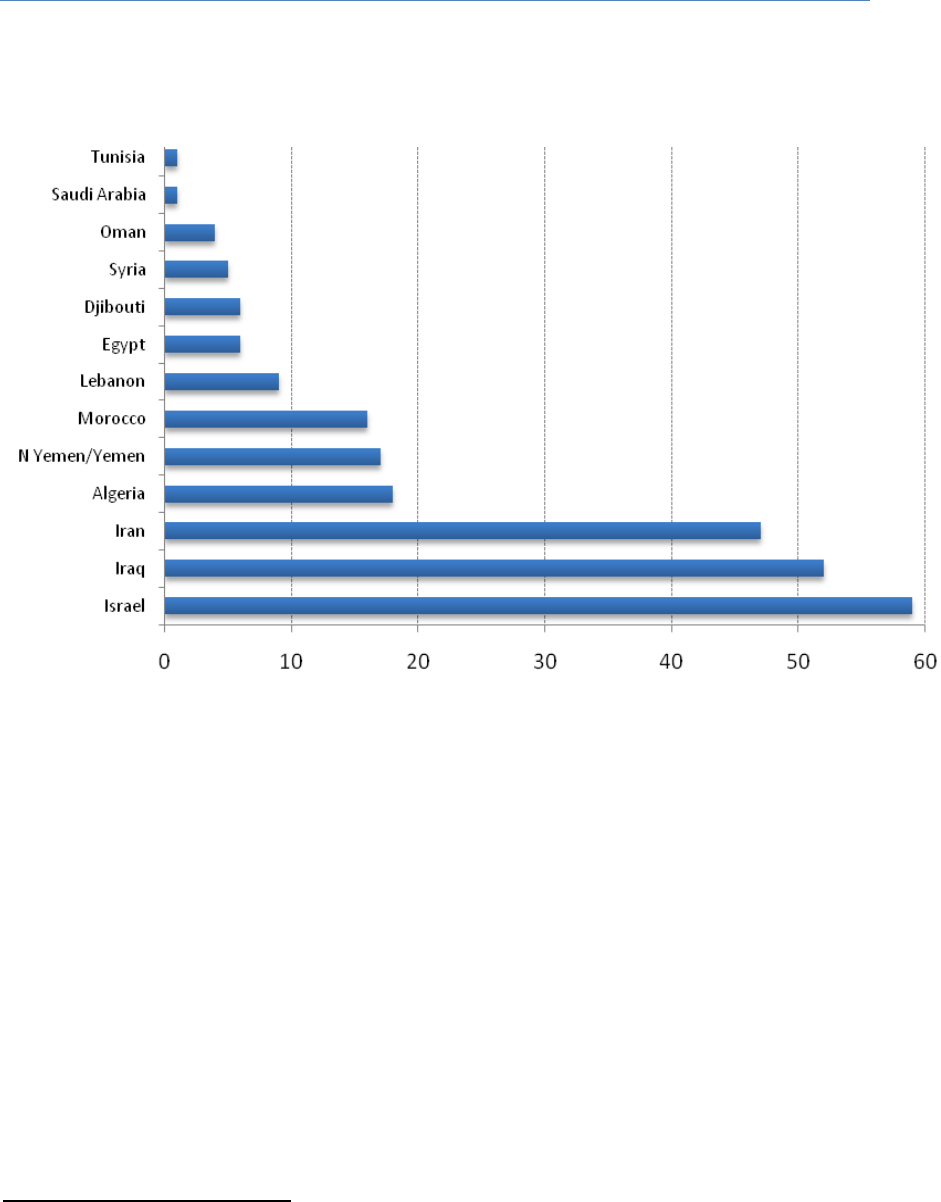
Reducing Conflict Risk: Conflict, Fragility and Development in MNA
-4-
Figure 1: Conflict-Years in the MENA Region, 1960-2009
Source: Michael Ross, Nimah Mazaheri, and Kai Kaiser, “The „Resource Curse‟ in MENA” Resource Wealth,
Economic Shocks, and Conflict Risk”, background paper for the 2011 World Bank Study on Conflict and
Development in the MENA Region, 2011; calculated from data in Gleditsch et al. (2002) and Harbom and
Wallensteen (2010)
7. These numbers are based on data predating the „Arab Spring‟. Whether recent violence in
MENA will reverse the declining trend yet, again remains too early to assess. Moreover, the study
acknowledges that a regional view prevails that it is unlikely that MENA will achieve a durable
and equitable peace as long as the Israeli-Palestinian conflict continues
8
. The centrality of this
conflict plays a major role in influencing local and global perceptions of the region and has at
least partly motivated international interest, involvement, and development assistance to the
region.
9
Political scientists, economists, anthropologists, and other scholars have attempted to
characterize this conflict and examine its drivers.
10
Nearly every such analysis demonstrates that
this conflict has become itself a source of further tension and violence within the MENA region
and globally. While development actors and assistance have a critical role in West Bank and
Gaza, this study provides a differentiated view of the Bank‟s assistance across the region and a
need to analyze drivers and development responses in specific contexts.
8
Evidenced by our consultations in the region which characterized the conflict as Israeli-Arab, not just Israeli-
Palestinian.
9
Edward E. Azar, Paul Jureidini, Ronald McLaurin, “Protracted Social Conflict; Theory and Practice in the Middle
East”, Journal of Palestine Studies, Vol. 8, No. 1 (Autumn, 1978), pp. 41-60
10
Dan Smith, “The State of the Middle East: an Atlas of Conflict and Resolution”, University of California Press,
Berkeley, 2
nd
edition, 2006, 2008

Reducing Conflict Risk: Conflict, Fragility and Development in MNA
-5-
Conflict's Impact on Human and Economic Development in MENA
8. The development community is increasingly realizing that conflict cannot be separated
from development agendas. Not a single low-income, fragile state has achieved any of the MDGs
and fragile, conflict-affected, and „recovering‟ states account for 77 percent of all school-age
children not enrolled in primary school, 61 percent of the world‟s poor, and 70 percent of infant
mortality.
11
Conflict shortens life expectancy and kills people on and off the battlefield – through
direct acts of violence and as a result of deprivation and reduced service provision – both during
conflict and for years after war has ended. Economic conditions also decline, and years of relative
peace and stability are required to allow a conflict-affected context to return to its pre-conflict
economic state. This same process of rapid decline during conflict followed by a slow and partial
return to the status quo ante commonly also applies to governance and the quality of public
administration.
12
Conflict also has intangible effects on cultures, societies and social cohesion,
important elements which has been beyond the scope of this study.
Millennium Development Goals
9. As mentioned earlier, the region has hosted a disproportional number of conflicts, which
have also tended to more lethal due to heavy international involvement and aerial bombardments.
Direct combat is not the only origin of causalities of war, even more people die as a result of
related causes, including the spread of infectious disease, the destruction of assets, the loss of
support mechanisms and the diversion of government spending away from basic services.
Estimates suggest that the number of indirect deaths attributable to conflict is roughly double the
actual number of direct conflict deaths in the MENA region.
13
Evidence from the conflict in Iraq
since 2003 demonstrates that three indirect deaths have occurred for each one direct combat
death. During the first Gulf War in 1991, this ratio was as high as 3.3 to one.
14
10. War-related deaths also result in shortened life expectancy. Globally, five years of
conflict decrease life expectancy by 4.5 years. In the MENA region such a decline would reduce
life expectancy from 72 to 67.5 years of age on average. However, data from the MENA region
suggests that the average conflict lasts four years and has a slightly more detrimental effect upon
life expectancy, resulting in a decline of approximately five years.
15
11
World Bank, “World Development Report 2011”, p. 63.
12
Hegre and Nygård, “The Governance-Conflict Trap in the ESCWA Region”, a paper for the UN-ESCWA study on
“The Governance Deficit and Conflict Relapse in the ESCWA Region”, 2011.
13
Gates, et al., “Consequences of Armed Conflict in the MENA Region”.
14
See Krause, Muggah, and Wennmann, “Global Burden of Armed Violence”, Geneva: Geneva Declaration
Secretariat, Small Arms Survey, 2008.
15
Gates, et al., “Consequences of Armed Conflict in the MENA Region”.
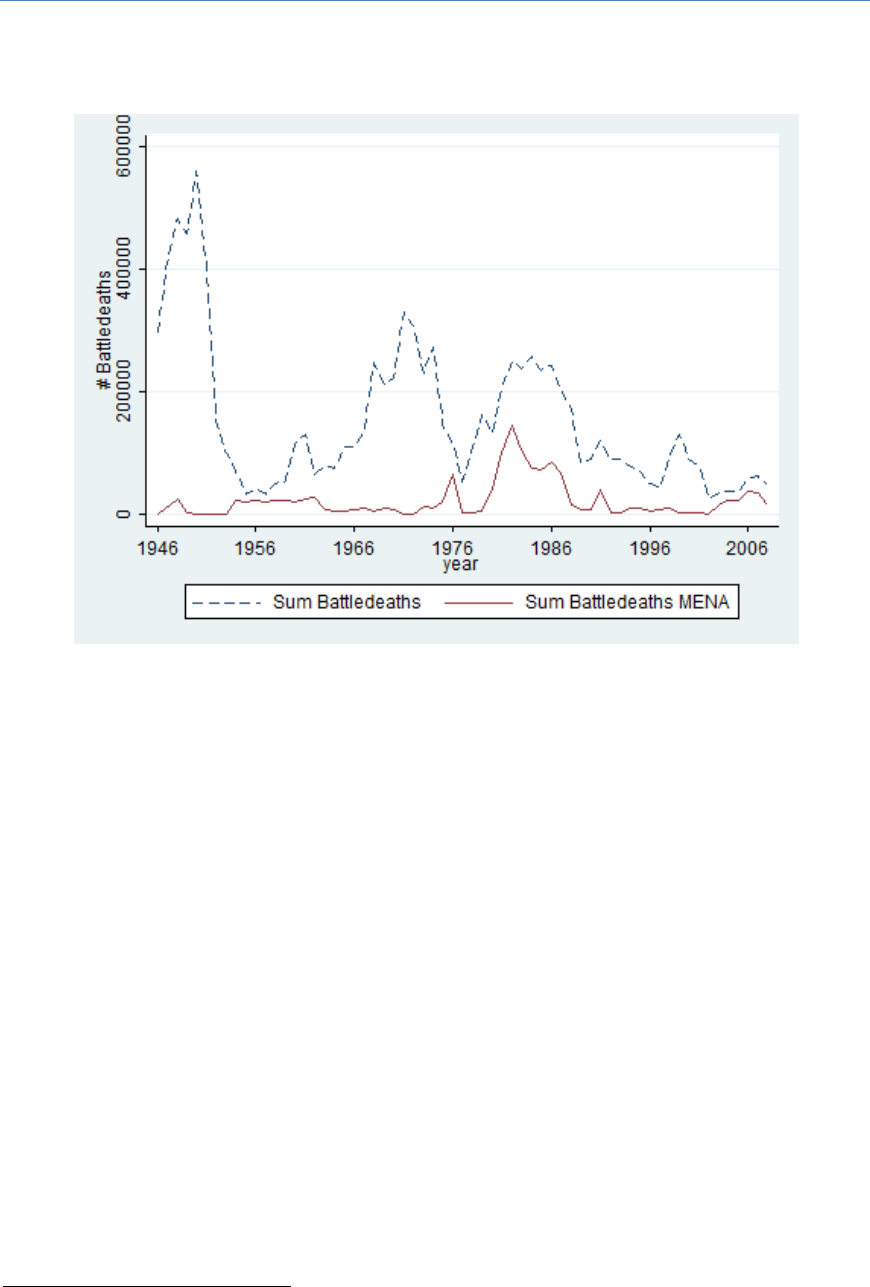
Reducing Conflict Risk: Conflict, Fragility and Development in MNA
-6-
Figure 2: Total Battlefield Deaths in Global and MENA Conflicts, 1946-2008
Source: Gates, et al., “Consequences of Armed Conflict in the MENA Region”.
11. An increased rate of infant mortality has contributed significantly to shortened life
expectancy in the conflict-affected countries in the region. While the average increase of 1.17
percent in infant mortality rate per conflict year may appear small, the cumulative effect
translates into additional infant deaths comparable in number to direct battle deaths. In other
words, one infant which otherwise would have survived is likely to die for every person who dies
as a result of violence during the conflict. Further, the impact of conflict on infant mortality
persists for many years after violence has ended, in part due to its effect on health infrastructure
and services.
16
12. While conflict has clear detrimental effects on achieving the Millennium Development
Goals globally as described above (except combating HIV/AIDS), the correlation between
conflict and such deterioration is a lot less clear in the MENA context. In addition to life
expectancy and infant mortality discussed above, conflict in MENA negatively affects primary
school enrolment gender ratios, and access to water. Econometric analysis shows that one year of
minor conflict decrease the population with adequate access to water with almost 0.9 percent. On
average, 10 percent of the populations in MENA do not have sufficient access to water, after five
years of conflict this number would rise to almost 15 percent.
17
16
Gates, et al., “Consequences of Armed Conflict in the MENA Region”.
17
Gates, et al., “Consequences of Armed Conflict in the MENA Region”.

Reducing Conflict Risk: Conflict, Fragility and Development in MNA
-7-
Displacement
13. Negative impacts of conflict on health and mortality may particularly affect refugee
populations and internally displaced persons (IDPs). The MENA region is home to two of the top
three refugee-producing nations, Palestine and Iraq, as well as four of the top five refugee-hosting
locations, including the West Bank (762,000 refugees), the Gaza Strip (1.1 million), Syria (1.76
million), Iran (1.0 million), and Jordan (621,000).
18
Furthermore, the West Bank and Gaza,
Jordan, Syria, and Lebanon have the highest proportion of refugees to host-nation populations in
the world. In many locations in the MENA region, displacement has not been a temporary
phenomenon but rather one which has persisted for decades uninterrupted.
19
14. Refugees put significant economic and social pressure on their host governments and
societies. According to the Syrian government, for example, demand for subsidized bread rose by
35 percent after the Iraqi refugee influx in 2006, costing the Syrian state US$34 million, while
18
Scott and Nezam, “More Than a Humanitarian Matter? Displacement and Development in the Middle East”,
background paper for the World Bank Study on Conflict and Fragility in the MNA Region, 2009.
19
World Bank, “World Development Report 2011”, p. 61.
Box B: Gendered impacts of conflict in MENA
As elsewhere, the impacts of conflict affect men and women differently in the MENA region. However,
these gender-specific impacts are more nuanced within conflict-affected and fragile countries in the
region, depending on the particular contexts. For example in 2000 globally, in non-conflict countries,
around 98 percent of girls received primary education whereas in countries in active conflict this figure
was down to 91 percent, with post-conflict countries in between. However, cross-regional research for
this study suggests there may be no statistically significant impact of conflict on girls‟ access to
education. This finding may be influenced by data paucity or by opposing forces which cancel each
other out. For instance, girls‟ access to formal education systems may be interrupted during conflict, but
local and international actors‟ aid programs compensate for this loss.
Another example is a World Bank report from 2010 relaying findings on the gendered dimensions of
conflict and economic collapse in the West Bank and Gaza. The report notes that while economic
hardship has allowed educated women, in particular, to explore various employment opportunities and
take a greater role outside of the home, it has forced many women into low-paying, menial work or has
pushed them to take the risk of borrowing money on behalf of their families. Even where such
opportunities may be considered “empowering” by some within and outside of the Palestinian context,
the report notes that many women are not comfortable with the new roles, with the added risk (e.g., with
the need to face Israeli checkpoints), or with the marital disharmony that their new economic role often
inspired. Some men, the report notes, have grown increasingly depressed, angry, and hostile as they feel
humiliated by harsh treatment and unemployment.
Sources: Gates, et al., “Consequences of Armed Conflict in the MENA Region” and World Bank “Checkpoints and Barriers:
Searching for Livelihoods in the West Bank and Gaza – Gender Dimensions of Economic Collapse” , Washington, DC: World
Bank, 2010.

Reducing Conflict Risk: Conflict, Fragility and Development in MNA
-8-
demand for water rose by 21 percent, at a cost of almost US$7 million per year.
20
Other costs of
hosting refugee populations include social services and security. Refugee populations may also
contribute to political instability in the region; notable examples of conflicts which involved and
were partly influenced by refugee inflows include Black September in Jordan in 1970, the
Lebanese Civil War (1975-1990), and the more recent violence in and around the Nahr el-Bared
Palestinian refugee camp in Lebanon in 2007.
21
15. Per capita income for Palestinian refugees were also stifled; while the average
Jordanian‟s per capita monthly income was US$183, it was US$91 for a Palestinian refugee. In
Lebanon, a Palestinian refugee could expect to earn only one-quarter as much as the average
Lebanese (US$127 vs. US$501 per month).
22
In addition to limited employment opportunities
and reduced income, refugees are subject to overcrowding and poor-quality housing in many
instances.
23
While discussions of conflict-induced displacement in MENA had commonly focused
on the situation of Palestinians, the recent war in Iraq has created another major refugee and IDP
crisis with an estimated 1.7 million refugees in Syria, Jordan and Lebanon.
24
Rather than settling
in camps, most Iraqi refugees have integrated themselves into urban areas, making them difficult
to identify and assist. Their informal status forces them to work long hours for relatively little
money; poverty and host governments‟ reluctance to open schools to Iraqi refugees have forced
some Iraqi children into the labor market.
25
Economic Development
16. The WDR 2011 finds that “countries affected by violence throughout the 1980s lagged in
poverty reduction by 8 percentage points, and those which experienced major violence
throughout the 1980s and 1990s lagged by 16 percentage points”.
26
As this finding suggests, the
economic impact of conflict is frequently long-lasting. However, in MENA this effect is
somewhat muted thanks to its oil wealth and the remarkable resiliency of many of the region‟s
non-oil economies. In MENA, the speed of recovery from conflict in economic terms can at times
(with exceptions) be quite impressive.
27
Lebanon, for instance, managed to grow its economy
during its civil war, and, following the 2006 „July War”, the country experienced GDP growth of
more than nine percent per annum. Relative to other regions of the world, where the negative and
lasting economic consequences of war are readily certain, some countries in post-conflict
situations in MENA have a greater ability to recover.
28
MENA countries, whether because of the
20
Al-Khalidi, Ashraf, Hoffman, and Tanner, “Iraqi Refugees in the Syrian Arab Republic: A Field-Based Snapshot,”
Brookings-Bern Project on Internal Displacement, June 2007.
21
Scott and Nezam, “More Than a Humanitarian Matter? Displacement and Development in the Middle East”.
22
Bocco, Brunner, Al Husseini, Lapeyre, and Zureik, “The Living Conditions of the Palestine Refugees registered with
UNRWA in Jordan, Lebanon, the Syrian Arab Republic, the Gaza Strip and the West Bank”, Geneva and Louvain:
Graduate Institute of International and Development Studies in Geneva and the Catholic University of Louvain, 2007.
23
For instance, 70 percent of Palestinians in refugee camps in Jordan report overcrowding; that number is 73 percent in
Syria and 71 percent in Lebanon. See Bocco, et al., “The Living Conditions of the Palestine Refugees”, p. 92.
24
See Scott and Nezam, “More Than a Humanitarian Matter? Displacement and Development in the Middle East”.
25
Ibid.
26
World Bank, “World Development Report 2011”, p. 60.
27
Ibid.
28
Gates, et al., “Consequences of Armed Conflict in the MENA Region”.
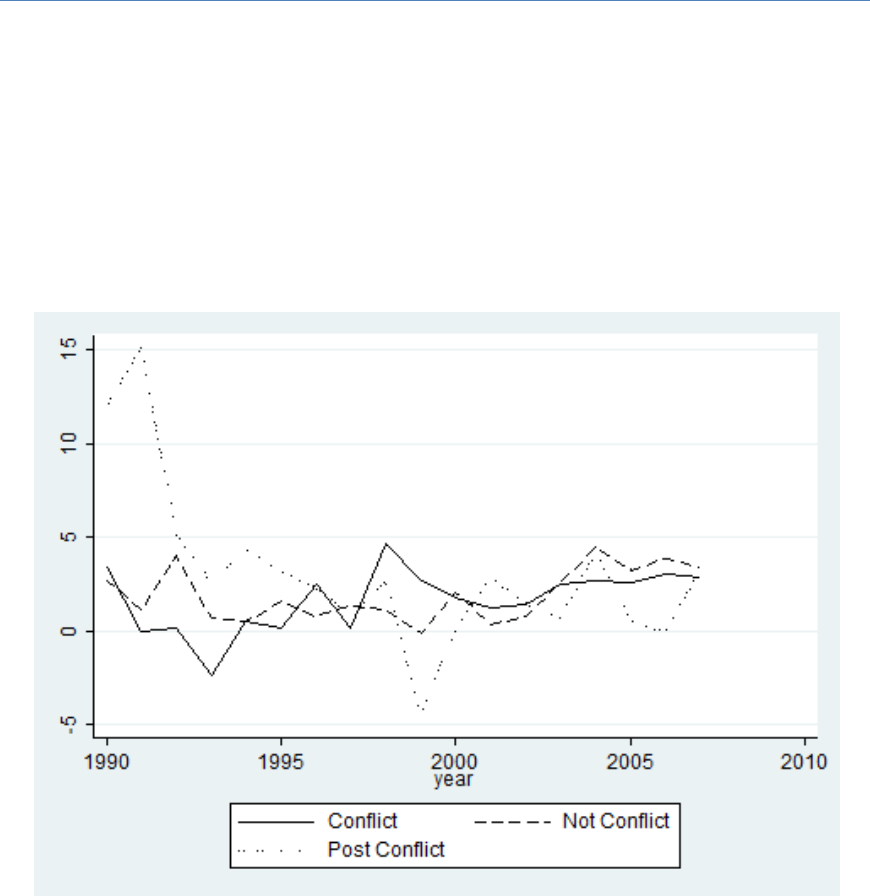
Reducing Conflict Risk: Conflict, Fragility and Development in MNA
-9-
region‟s oil revenues, an entrepreneurial spirit, or other factors, have the ability to experience
rapid post-conflict growth. For some this level may allow them to return to an economic position
similar to that of countries which had not experienced a conflict. Of course, the ability of some
MENA states to grow quickly after conflict should not be taken to mean that many others,
including Yemen and the West Bank and Gaza, do not continue to experience significant
economic hardship before, during, and after conflict.
Figure 3: GDP Growth in MENA, 1990–2008
Source: Gates, et al., “Consequences of Armed Conflict in the MENA Region”.
III. CONFLICTS IN MENA: KEY DRIVERS
17. This section examines those „drivers‟ which make countries within the MENA region
more (or less) likely to experience conflict. The choice of the term „drivers‟ over the narrower
„causes‟ is deliberate, as the term implies a more contextually situated and dynamic nature. The
specific drivers assessed within this study include the following: (i) low or declining per capita
incomes, (ii) large youth cohorts, (iii) regime types and transitions, (iv) deficits in the quality of
governance, (v) energy (oil and gas) resource dependence, (vi) and identity and inequality. This
list of issues is far from exhaustive, focusing on those drivers which appear to have general
applicability across the MENA region rather than those specific to particular countries or
contexts. For example, religious fractionalization may be an important driver of conflict in certain
situations, but econometric research done for the study showed no overall regional causality

Reducing Conflict Risk: Conflict, Fragility and Development in MNA
-10-
between the two.
29
Further, emphasis is placed on factors amenable to mitigation through
development intervention. This may result in larger political and diplomatic issues such as
disputed borders or regional and international interference, which are relevant to the MENA
region but not part of the World Bank mandate, receiving less attention.
Economic Decline and Large Youth Cohorts
18. Low per capita incomes increase the risk of conflict onset in the MENA region, but their
effect appears significantly weaker in MENA than for a global sample of countries. For instance,
a relative decline in per capita income of 10 percent (relative to the preceding level of income) is
likely to render a country at greater risk of conflict elsewhere in the world than in MENA. The
interplay of economics and conflict in MENA is at best limited and other variables either mediate
the effects of economic factors or play much larger roles as drivers of conflict in the region.
30
19. Such a finding highlights the inadequacy of standalone economic variables as sources of
conflict risk. Research suggests that poor economic performance may be far more likely to lead to
conflict when significant numbers of youth, particularly unemployed young men, are present.
Large youth cohorts do not in themselves lead to instability or conflict; rather the conflict
potential of youth bulges is linked to the opportunity structure determined by factors such as
educational attainment, employment opportunities, family formation, and means of political and
civic participation.
31
However, a correlation between populations with a large youth cohort
relative to the adult age population, and an increase in the likelihood of domestic armed conflict
has been shown.
32
An increase in youth bulges of one percentage point increases the risk of
conflict by approximately seven percent, while countries with youth bulges of 35 percent are
three times more likely to experience conflict than countries with a youth bulge equal to the
median for developed countries.
33
29
Sambanis and Choucair-Vizoso, “Conflict and Development in the Middle East and North Africa”.
30
Sambanis and Choucair-Vizoso, “Conflict and Development in the Middle East and North Africa”.
31
Barakat, Paulson, and Urdal, “Youth, Transition, and Conflict in the Middle East and North Africa”, background
paper for the 2011 World Bank Study on Conflict and Development in the MNA Region, 2010.
32
Stateveig, “Young and the Restless: Population Age Structure and Civil War”, ECSP Report 11, 2009, pp. 12-19;
Urdal, “The Devil in the Demographics: The Effect of Youth Bulges on Domestic Armed Conflict, 1950-2000”, World
Bank Social Development Paper, Washington, DC: World Bank, Conflict Prevention and Reconstruction Unit, 2004.
33
Urdal, “The Devil in the Demographics”, p. 9.
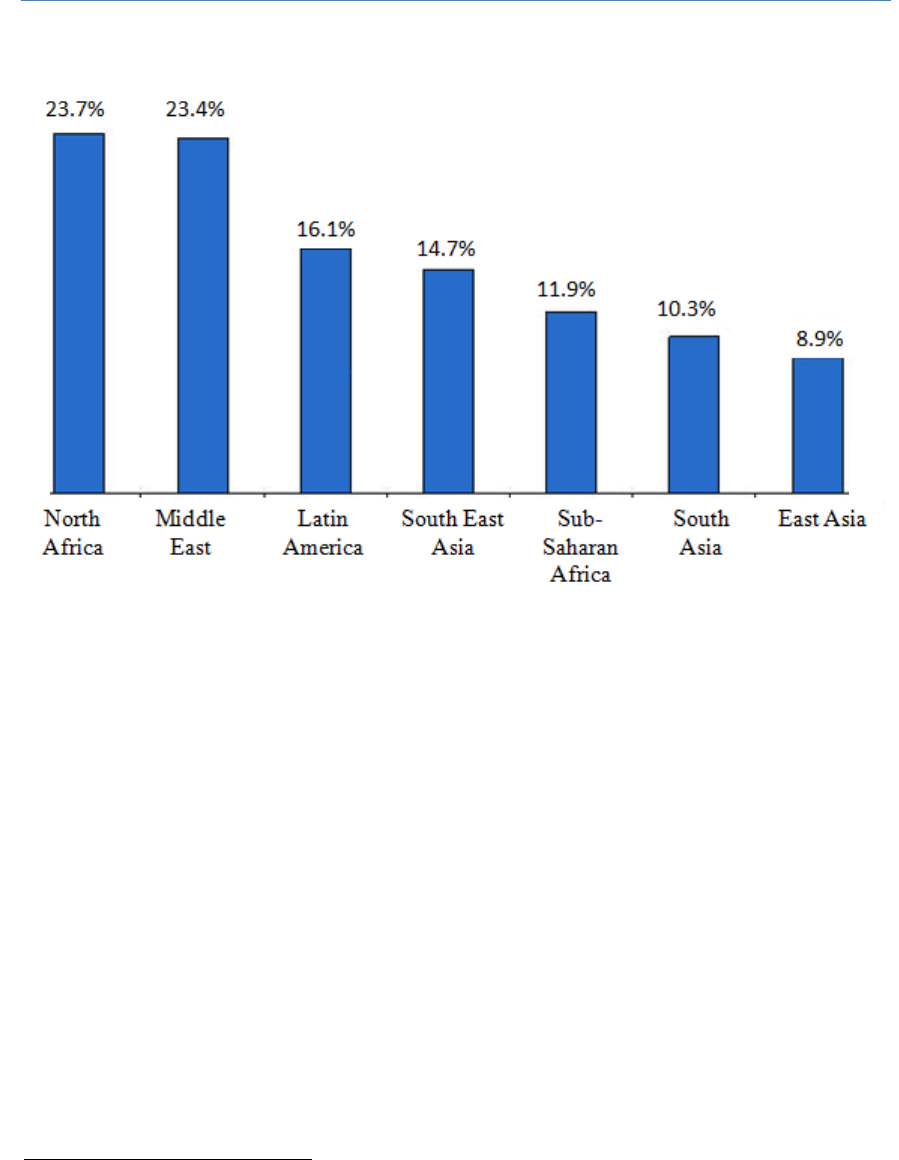
Reducing Conflict Risk: Conflict, Fragility and Development in MNA
-11-
Figure 4: Youth (15-24 years of age) Unemployment in MENA and Other Regions, 2009
Source: ILO, Global Employment Trends for Youth , Geneva, International Labour Office, Aug. 2010, p. 63.
Regime Types and Transitions
20. Globally, evidence suggests that regimes which are neither authoritarian nor genuinely
democratic have the greatest vulnerability to conflict onset.
34
Yet, data on MENA up to 2010
suggests that “anocratic” (or semi-democratic) regimes have in fact been more resilient in MENA
countries than anywhere else in the world. A MENA semi-democracy was “many times more
stable than similar regimes in other parts of the world - much more stable than a Sub-Saharan
African democracy, and more stable than autocracies in most parts of the world”.
35
In contrast to
global trends since the 1960s, MENA countries had not democratized and the region has been
characterized by “a freedom deficit,” as coined by the first UNDP Arab Human Development
Report.
36
21. MENA accounted for 17 percent of the world‟s coups between 1946 and 2006, and was
home to two of the world‟s eight most coup-prone countries (Syria with 20 coups and Iraq with
15).
37
Thirty-five percent of all leaders in MENA entered power in an irregular way, such as
through coups. Surprisingly, however, statistical analysis showed that having a coup in the last
three years does not increase civil war risk.
38
Instead, data from MENA suggests that changes in
34
Barakat and Urdal, “Breaking the Waves? Does Education Mediate the Relationship Between Youth Bulges and
Political Violence?”, World Bank Policy Research Working Paper 5114, 2009; Hegre, Ellingsen, Gates and Gleditsch,
"Toward a Democratic Civil Peace? Democracy, Political Change, and Civil War, 1816–1992", American Political
Science Review, 95:1, 2001, pp. 33-48.
35
Gates, et al., “Consequences of Armed Conflict in the MENA Region”.
36
“Arab Human Development Report”, 2002.
37
Syria is the one country in the world with three successful coups in 1949 and three attempts in 1975.
38
Sambanis and Choucair-Vizoso, “Conflict and Development in the Middle East and North Africa”.

Reducing Conflict Risk: Conflict, Fragility and Development in MNA
-12-
leadership within a country, particularly those which bring a country from one autocratic regime
to another, have historically resulted in greater susceptibility to conflict onset.
39
Somewhat
unexpectedly, conflicts did not occur alongside or immediately following the regime changes or
coups in these cases; rather, political violence emerged within two years of those leadership
changes.
40
In some cases, the new leadership was perceived as being weak spurring groups to
challenge the regime and pursue their own interests. In other instances, the conflict was more
closely linked to the introduction of internal security strategies intended to help newly
empowered leaders to firmly establish their control - more violent military action prompted more
violent insurgencies which evolved into further violence.
Weak Governance and Rental Dependence
22. Econometric analysis carried out for this MENA-specific study indicates the existence of
a strong linkage between conflict and poor governance in the Middle East and North Africa. One
of the study‟s background papers investigated a set of indicators capturing several aspects of
governance: formal political institutions, political exclusion and repression, the rule of law,
corruption, bureaucratic quality, military influence in politics and economic policies. By
constructing a composite index, the authors find that not only is it “the worst governed region in
the world”, there was no improvement during the reviewed period.
41
In fact, most indicators were
stagnant or deteriorating. Using statistical models to estimate the risk of conflict relapse in the
region, the authors show how the risk of renewed conflict in countries with good governance
drops rapidly after the end of the conflict. In those characterized by weak governance however,
this process takes a lot longer. To make matters worse, conflict then leads to a further reduction in
the quality of governance and undermines the near-term prospects for improved governance in
MENA.
42
Put another way, a poorly governed country is likely to fall into a self-reinforcing cycle
of conflict and bad governance.
Table 1: Average WGI Percentiles for MENA Countries, 2009
Governance Indicator
Regional
Average
Iraq
Lebanon
W. Bank &
Gaza
Yemen
Voice and Accountability
23.2
13.7
35.5
20.4
11.8
Political Stability
38.6
1.9
9.0
3.8
2.4
Government Effectiveness
47.8
8.1
30.5
21.4
11.4
Regulatory Quality
48.3
15.2
50.5
49.5
29.5
Rule of Law
49.0
1.4
32.1
44.8
13.2
Control of Corruption
49.1
4.8
22.9
39.0
15.2
Note: Given that percentiles are displayed above, the global average for each governance indicator is approximately 50. Scores
closest to 100 represent the “best” governance scores and those closer to 0 are the “worst”.
Source: http://info.worldbank.org/governance/wgi/index.asp
39
Sambanis and Choucair-Vizoso, “Conflict and Development in the Middle East and North Africa”.
40
Ibid. These leadership changes comprise: Algeria (1962), Iran (1979), Iraq (1959 and 1961-70), Oman (1971-75),
Turkey (1984-99), and North Yemen (1948 and 1962-70).
41
Hegre and Nygård, “The Governance-Conflict Trap in the ESCWA Region”.
42
Hegre and Nygård, “The Governance-Conflict Trap in the ESCWA Region”.

Reducing Conflict Risk: Conflict, Fragility and Development in MNA
-13-
23. Even when compared with countries that have similar incomes, the MENA region ranks
at the bottom on the Worldwide Governance Indicators index of overall governance quality. One
possible contributor to this weak governance is the presence of oil revenues not only in oil-
exporting nations but also in states which are significantly dependent upon oil and cash flows
from oil exporters.
43
Among countries at all income levels since 1960, the conflict rate in the oil
states has been about 40 percent greater than in non-oil states. And since the Cold War ended, it
has been almost 50 percent greater. Conflict risk among low-income oil states, such as Yemen,
has been twice as great as in non-oil states since 1992.
44
Countries with large oil revenues and
small populations are the least likely to experience conflict while countries such as Iraq, Iran, and
Algeria with large oil revenues and sizable populations will have an average (though not
necessarily elevated) level of conflict risk.
45
Figure 5: Oil Prices and Conflicts in MENA, 1960-2009
Source: Ross, et al. “The “Resource Curse” in MENA? Resource Wealth, Economic Shocks, and Conflict Risk”.
24. Furthermore, the instability of global oil prices also leads to macroeconomic shocks in
major oil-exporting nations which may add to the risk of conflict. For example, MENA‟s conflict
trend closely mirrored the global trend in number of conflicts except for period from 1978 to
1984, which included positive (1978-79) as well as negative (1979-84) oil price shocks.
46
Finally,
as suggested in the preceding section on governance quality, research has demonstrated the
corrosive influence which natural resource wealth, particularly oil wealth, may have upon the
43
Ross, Mazaheri, and Kaiser, “The „Resource Curse‟ in MENA”.
44
Here the calculations are based on a definition of “low-income countries” which only includes those below the
$5,000 per capita threshold; MENA states such as Libya, Kuwait, and Saudi Arabia are, hence, not included in the
calculations.
45
Lust-Okar and Sambanis, “The Political Economy of Internal Armed Conflict in the Middle East and North Africa”.
46
Ross, Mazaheri, and Kaiser, “The „Resource Curse‟ in MENA”.

Reducing Conflict Risk: Conflict, Fragility and Development in MNA
-14-
quality of governance and public institutions.
47
Oil and gas revenues or „rents‟ may thus be
understood as an intervening variable which increases conflict risk by weakening the quality of
governance. One explanatory theory is that states with significant oil and gas revenues do not
need to tax their citizenries and, hence, have little need to earn the acquiescence of their
populations to taxation. Instead, the state is able to use its resource-derived wealth to provide
subsidies and distribute rents through other means.
48
Alternatively, rentier states, as rentally
dependent nations are often referred to, may bypass the bulk of the populace and, instead, focus
their efforts on buying the loyalty and allegiance of a narrow band of key elites.
49
The
securitization of oil-exporting nations has further been facilitated and encouraged (e.g., through
the provision of military hardware, training, etc.) by oil-importing nations.
50
Identity and Inequality
25. Identity and inequality are among the additional range of drivers of conflict and fragility
discussed in the literature and other background studies. Yet data limitations make it difficult to
assess to what degree these are applicable in MENA with the same degree of precision and
objectivity as some of the previously discussed factors. For instance, some measures of identity
consider MENA to be among the most homogenous regions of the world, with a primarily Arab
background and limited degree of linguistic and religious diversity. Yet other measures which
account for sectarianism and other factors provide a divergent perspective.
51
Some studies find
that dominance by one identity group in the MENA region renders conflict more likely but finds
that fractionalization – the division of societies between several identity groupings without a
47
Barma, Kaiser, and Tuan Minh Le, “Rents to Riches? The Political Economy of Natural Resource Led
Development”, Washington, DC: World Bank, 2011.
48
Al-Rasheed, “A History of Saudi Arabia”, New York: Cambridge University Press, 2002; Vandewalle, “Libya since
Independence: Oil and State-Building”, Ithaca, NY: Cornell University Press, 1998.
49
For a case study of this dynamic in Iran, see Karshenas, “Oil, State, and Industrialization in Iran”, New York:
Cambridge University Press, 1990.
50
Ross, Mazaheri, and Kaiser, “The „Resource Curse‟ in MENA”.
51
See discussion of various classification and coding problems related to fractionalization in Sambanis and Choucair-
Vizoso, “Conflict and Development in the Middle East and North Africa”.
Box C: International and Intra-Regional Involvement
Although beyond the scope of development intervention, the study acknowledges that the involvement
of outside nations, whether regional or foreign actors, has been another factor influencing conflict in
MENA. Such involvement may entail military invasion and intervention, as in Iraq‟s invasion of
Kuwait in 1990 or the international invasion of Iraq in 2003.
Alternatively, they may involve the provision of financing, materials, weapons, training, technical
assistance, logistical support, intelligence, or diplomatic backing to governments, political factions,
non-state actors, or others in a foreign country. External support to Israel, and Israeli, Syrian, Iranian,
and other support to various factions within Lebanon are just some examples from MENA.
Sources: World Bank data

Reducing Conflict Risk: Conflict, Fragility and Development in MNA
-15-
single one being dominant – does not reduce conflict risk, thus providing a useful yet
theoretically unsatisfying explanation of the identity conflict interface in the region.
52
26. Evidence does suggest, however, that identity combined with horizontal equality (e.g., on
the basis of religion, ethnicity, etc.) may have a relation to conflict. In the MENA region
specifically, horizontal economic inequality between Lebanon‟s various regions and populations
appeared to play a major role in the country‟s civil war despite the fact that overall economic
growth continued.
53
Differential growth rates, particularly the implementation of state policies
exacerbating disparities in access to resources, have also been linked to several conflicts in the
region.
54
27. MENA has one the most equal income distributions in the world as measured by the Gini
coefficient, and is closely on a par with Europe, Central Asia and South Asia. It is significantly
lower than Latin America and sub-Saharan Africa. MENA has also had the largest reduction in
income inequality between the 1980s and 1990s.
55
This measurement only quantifies vertical
inequality (i.e., the level of inequality between individuals without reference to inter-group
differences) which is believed to foster criminal activity and violence. Horizontal inequality
(inter-group or inter-regional inequality) has on the other hand been associated with conflict
onset.
56
Horizontal inequality also has an important non-material side. When inequalities result
from inter-group differences in justice, inclusion and access to power, material imbalances in
wealth and income are only one outcome. In addition, “economic stresses” may be amplified by
social factors such as “humiliation, pride, [shame], and desire for affiliation”
57
As in the case of
ethnic fractionalization, problems of coding and collection of data still hinder thorough analysis
of the relationship between horizontal inequality and conflict.
Merging Drivers and Impacts of Conflict in MENA
28. The concept of a „conflict trap‟ emerged from the observation that conflicts produce (or
re-create) conditions which may cause future conflict in a cyclical manner. Ninety percent of
conflicts which began in the first decade of the 21st Century were in countries which had already
experienced a civil war. By comparison, the same held true for only 43 percent of conflicts in the
1960s and 57 percent of conflicts in the 1970s.
58
52
See Sørli, Gleditsch and Strand, “Why Is There So Much Conflict in the Middle East?”, Journal of Conflict
Resolution, 49:1, 2005, p. 151.
53
Kamal, “Lebanon explodes,” MERIP Reports, 44, 1976; and Makdisi and Sadaka, “The Lebanese Civil War, 1975–
1990” in Collier and Sambanis, eds, “Understanding Civil War: Evidence and Analysis”, vol. 2, Washington, DC,
World Bank, 2005.
54
Jones, “Among ministers, mavericks and mandarins‟: Britain, covert action and Yemen Civil War, 1962-64,” Middle
Eastern Studies, 40, 2004, pp. 99-126.
55
Sambanis and Choucair-Vizoso, “Conflict and Development in the Middle East and North Africa”.
56
This issue is examined in greater detail in Chapter 2 of the “World Development Report 2011”.
57
World Bank, “World Development Report 2011”, pp. 81-82.
58
Ibid.

Reducing Conflict Risk: Conflict, Fragility and Development in MNA
-16-
29. Such a finding blurs the difference between drivers and impacts of conflict and fragility.
The role of economic conditions in driving repeated cycles of conflict, creating an „economic
conflict trap‟, was identified in 2003. This revealed that a “country that first falls into the trap is
10 times more at risk of a new war just after the war has ended, than before it started. If the
country succeeds in maintaining post-conflict peace for 10 years or so, the risk is considerably
reduced, but remains at a higher level than before the conflict”.
59
However, as previously noted in
this chapter, data shows that the most powerful drivers of conflict and fragility within MENA are
political (e.g., regime transitions, weak governance, rental dependence, and horizontal inequality)
rather than macroeconomic.
30. The „political conflict trap‟ operates similarly to an economic conflict trap. Conflict
within the MENA region induces leaders to become increasingly authoritarian. Conflict leads to
increased oppression and narrows or nearly eliminates opportunities for political expression or
opposition. Such a state of affairs exists not only during the conflict but also in the post-conflict
years as leaders come to fear that any loosening of their political and military grip could invite
further opposition. This situation limits economic growth and leads to widespread frustration
among a significant portion of the citizenry. Devoid of formal channels through which to
peacefully express its dissatisfaction, this citizenry may turn to protests, riots, terrorism,
insurgency, or conflict. Once again, the state responds to these challenges by further clamping
down and re-charging the political conflict cycle. Demonstrating the mechanisms underlying the
political conflict trap, 80 percent of MENA countries which were in the midst of a relatively
long-term conflict, or “durable war”, received the worst possible score on the Political Terror
Scale (PTS), meaning they routinely commit large-scale human rights abuses against their own
citizenries.
60
31. As the example of the role of rents in governance discussed above shows, political and
economic factors driving conflicts cannot be seen as neatly separate factors. Similarly, the various
drivers identified above may also „play‟ various roles, as some may contribute the initial
instigation of the conflict, whereas others may help explain escalation or recurrence. Ultimately, a
number of political, economic and social drivers operate together leading to violence and
instability. The resulting responses, whether increased authoritarianism and repression or
decreased economic opportunity, entrench original drivers or can create new grievances. The
diagram below attempts to give a stylized representation of how economic and governance
drivers can work in tandem to entrench a conflict trap.
59
Collier, et al., “Breaking the conflict trap”, p. 104.
60
See the Political Terror Scale web site: http://www.politicalterrorscale.org/ptsdata.php.

Reducing Conflict Risk: Conflict, Fragility and Development in MNA
-17-
Figure 6: Representation of Interconnected Conflict Drivers in MENA
Sources: World Bank data
32. As the diagram above reflects, the socio-economic and political/governance factors work
in tandem and further fuelled or diminished by the subjective experience of the concerned
populations. For example, joblessness is not merely a monetary lack but can also be a source of
shame, humiliation, and exclusion. It raises concerns about marriage prospects among youth and
engenders a broader sense of not only economic fragmentation but also social isolation. The same
can be said in many respects of abuses by the state and its security services, which lead to not
only physical pain but a sense of betrayal and ever-present trepidation. Weak or illegitimate
regimes not only fail to meet expectations but stand as a constant source of frustration and as an
impediment to individuals‟ and societies‟ development, particularly when undermined by
rampant corruption and inequity.
Economic Dependence on Oil
and Gas Revenues (i.e., Rental
Dependence)
External Actors (e.g., Oil
Importers‟) Desire for Regional
Stability
Limited Non-State (civil society
or private sector) Models of
Good Governance
Limited Investments and Brain
Drain Hinder Job Growth &
Economic Diversification
Reliance on Security Services
to Discourage Opposition
Exclusion and Horizontal
Inequality (experienced as
humiliation and injustice)
Investment Flees, Increasing
Reliance on Extractive
Industries
Increased Securitization of the
State
Reduction of Voice and
Accountability, Increase in
Abuse by the State
Entrenchment of Initial Drivers of Conflict
Economic reliance on oil and gas is deepened, and private sector development is delayed
External actors re-emphasize need for regional stability and security
Opportunities for expression, including via civil society, are curtailed or forced underground
Governance is undermined, and state-citizenry divide widens
Governance Weaknesses
Limited institutional capacities and legitimacy
Constrained opportunities for citizen voice and accountability
Abuses of human rights and predation in the form of corruption
Limited and inadequate provision of common goods, including security, justice, and jobs
Outbreak of Opposition
May include protests, rebellion, terrorism, or other manifestations of opposition

Reducing Conflict Risk: Conflict, Fragility and Development in MNA
-18-
IV. THE WORLD BANK'S EXPERIENCE IN CONFLICT-AFFECTED
COUNTRIES IN MENA
33. Official development assistance (ODA) to MENA‟s fragile and conflict-affected states has
grown rapidly, with disbursements quadrupling from about US$6 billion in 2002 to nearly US$24
billion in 2008, primarily (though not exclusively) as a result of the conflict in Iraq.
61
Concurrently, civil society in the region has played an integral if somewhat under-recognized role
as social service providers, not least in areas most affected by insecurity. NGOs have played an
important role in service delivery in spite of generally having very close ties to the state. In
addition, Islamic charities are usually subject to more lax registration procedures and have been
able to use Zakat funds (almsgiving) to serve marginalized and vulnerable communities where the
state has often been absent.
62
34. The World Bank is one of many actors engaged in development assistance to conflict-
affected countries, working alongside other national and international development actors. The
World Bank‟s support has been guided by specific policies and procedures since 1998, as well as
dedicated staff and funding mechanism. The concept of “Low-Income Countries Under Stress”,
later superseded by the term “fragility”, was added to the agenda in 2001, thus enabling the
World Bank to move from its earlier “post-conflict” focus to a wider concern for conflict
prevention and risk reduction. Conflict and fragility are now seen as parts of a single agenda
aimed at increasing and refining the World Bank‟s support to peace building, state building and
governance.
63
The World Bank's experience in situations of conflict and fragility in MENA
35. This study focuses on those conflict-affected countries/territories in which the World
Bank has a lengthy record of assisting in the transition from violence to more peaceful forms of
dispute resolution. These include Iraq (which reentered the World Bank as client in 2004),
Lebanon, Yemen and the West Bank and Gaza.
64
The World Bank channeled almost US$5 billion
to these four countries/territories between 1998 and 2010,
65
an amount which comprised
approximately 490 lending, analytical and advisory activities. While only 177 of these activities
were lending operations, they accounted for US$4.7 billion of the US$5 billion spent.
66
Almost
70 percent of this amount was in the form of loans, while the remaining 30 percent were grants
61
Zyck and Barakat, “Development Assistance to the MENA Region‟s Zones of Conflict and Fragility”, background
paper to the World Bank Study on Conflict and Fragility in the MNA Region, 2010.
62
El Horr, “Civil Society in Fragile and Conflict-Affected Contexts in MENA: the emergence of NGOs and Islamic
Charities”, background paper to the World Bank Study on Conflict and Fragility in the MNA Region, 2010.
63
Re. description of OPCFC‟s mandate and as expressed by President Zoellick in his speech “Securing Development”
64
Algeria has also been affected by conflict and fragility in the period covered, it did however, not have an active
World Bank portfolio and has therefore not been included in this review.
65
Based on a portfolio review covering the calendar years 1998-2010. In World Bank terms this entails 14 fiscal years
FY97-FY11.
66
This figure includes funds from the International Development Association (IDA), from the International Bank for
Reconstruction and Development (IBRD), and from both global and country-specific trust funds
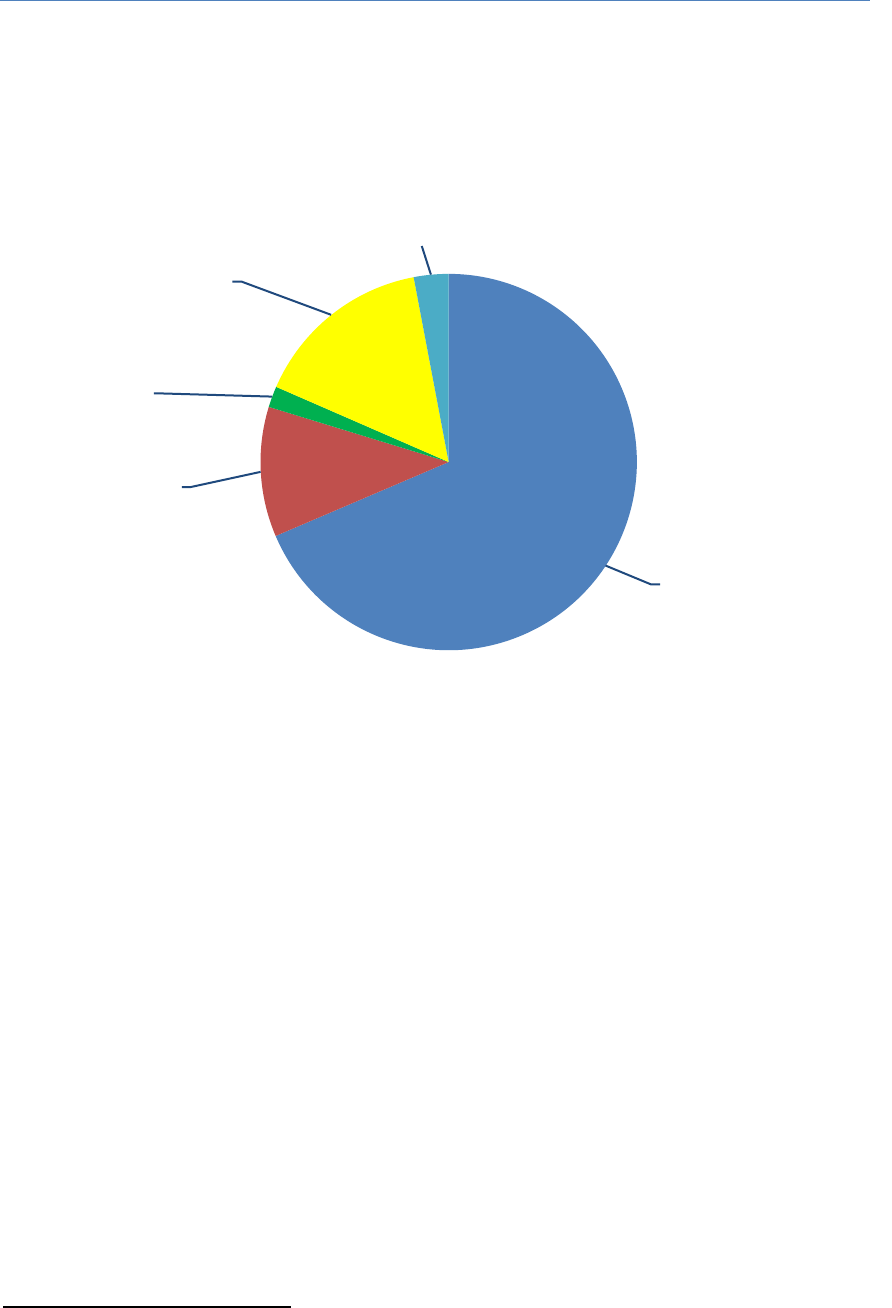
Reducing Conflict Risk: Conflict, Fragility and Development in MNA
-19-
coming from 13 different trust funds, a majority of which were country specific for the West
Bank and Gaza, and Iraq.
Figure 7: World Bank lending per source of funding
Source: World Bank data
36. The Bank‟s experience and traditional comparative advantage in poverty reduction and
development has led it to prioritize the mitigation of development related impacts of conflict and
fragility over the drivers of conflict.
67
World Bank activities have therefore also tended to be
reactionary in nature, with financing peaking in the periods after major security incidents.
Financing for the four countries has thus fluctuated significantly over the last decade spanning
from US$149 million in 2003 to US$871 million in 2010. That being said, the World Bank has
been able to provide rapid responses to crises and a significant number of projects have been
processed under emergency procedures hereby ensuring greater timeliness. These emergency
projects have also been less likely to require extensions due to implementation delays, delays that
were needed in approximately 80 percent of the projects using regular procedures.
67
See e.g. the World Bank ”The Role of the World Bank in Conflict and Development”, 2004.
IDA/IBRD lending
69%
Iraq Reconstruction
Trust Fund
11%
Trust Fund for
Lebanon
2%
West Bank and Gaza
Trust Funds
15%
Other trust funds
3%
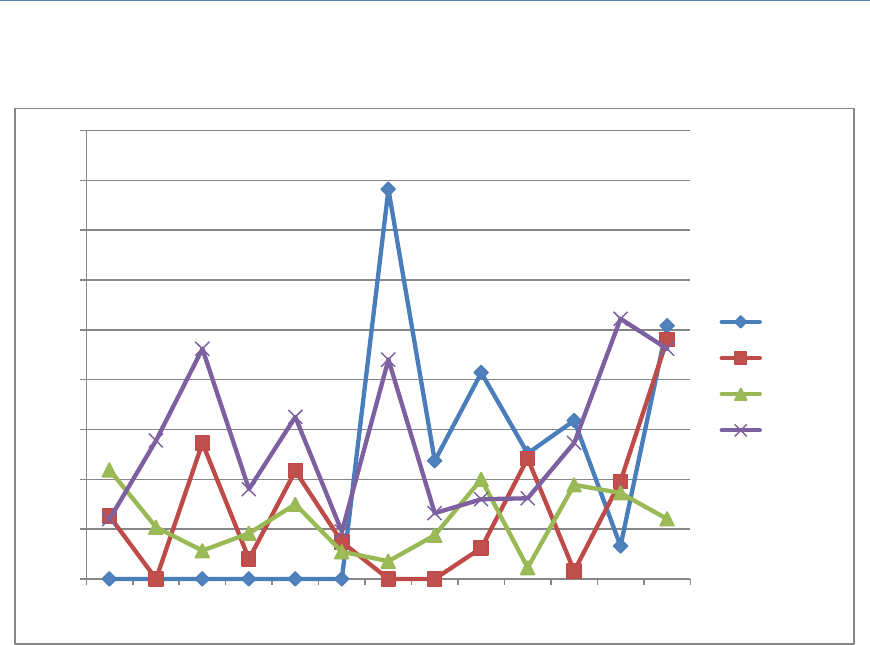
Reducing Conflict Risk: Conflict, Fragility and Development in MNA
-20-
Figure 8: World Bank Lending in US$ million per year
Source: World Bank data
37. The World Bank‟s tendency to address the consequences rather than drivers of conflict
has also had an impact on the choice of activities. Almost half of the projects were in the water
sector, education and urban development underlining the primary focus on service delivery and
mitigating the impact of conflict. Reviewing the lending portfolio suggests that the Bank has
made a large contribution to improved service delivery and infrastructure through its loans. In
addition, the use of traditional investment lending instruments has in many instances been equally
appropriate for conflict-affected and fragile situations. For example, supporting the equitable
management of natural resources has highlighted how this can help reduce tensions. Addressing
water-related conflict requires the kind of long-term perspective that promotes critical thinking
and thoughtful action for the common good, and can help build institutions and capacities for
wider beneficial impact beyond the water sector. There are thus inherent opportunities in all
water-related development interventions for building social capital, improving cooperation, and
fostering peace building.
0
50
100
150
200
250
300
350
400
450
1998
1999
2000
2001
2002
2003
2004
2005
2006
2007
2008
2009
2010
Iraq
Lebanon
WB&G
Yemen
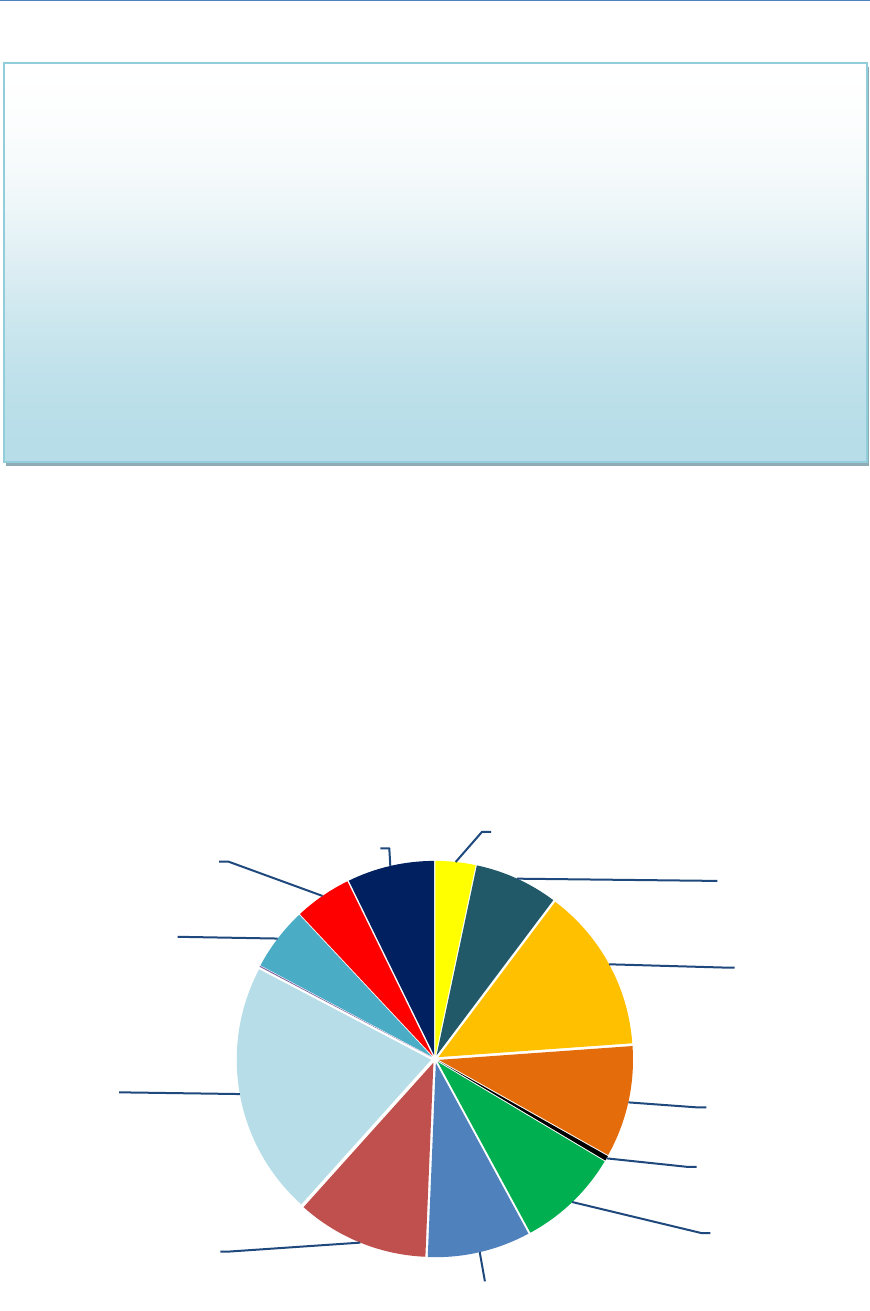
Reducing Conflict Risk: Conflict, Fragility and Development in MNA
-21-
38. Community-driven development projects have been supported by the Bank in conflict-
affected and fragile situations, stemming from expectations regarding their ability to contribute to
conflict resolution and the building of social capital, while delivering social services to
underserved populations. These projects have typically involved support for demand-side
governance, multi-sector sub-projects, capacity-building and inclusion of youth and women.
Actual experience shows that while these projects have generally been quite successful in
improving service delivery, the strengthening of human and social capital and cohesion are longer
term processes not easily amenable to short-term interventions.
Figure 9: World Bank funding to MENA conflict-affected countries 1998-2010
Source: World Bank data
Agriculture & Rural
Development
3%
Economic Policy
7%
Education
14%
Energy and Mining
9%
Environment
0%
Social Protection
9%
Transport
9%
Urban Development
11%
Water
21%
Financial & Private
Sector Development
5%
Health
5%
Public Sector
Governance
7%
Box D: World Bank Engagement in Water Management in Conflict-Affected Countries
One of the highest prioritized sectors in the four conflict-affected countries has been the water sector
with 21% of total lending amounts. The ownership, use, and distribution of valuable natural resources -
land, water, energy, etc.- has already been identified as a potential source of stress in the region and
equitable management of such resources can contribute to reducing this. Water conflicts indicate that
institutions fail to achieve the goals of water policy: fair distribution of benefits, economic efficiency
and environmental sustainability. Combining top down with bottom up governance of water resources
provides the best way to manage disputes: (i) At the national level, infrastructure adapted to modern
water use (and scarcity) is needed, as well as improved governance and management through flexible
institutions and organizations, and accountability and inclusiveness, to allocate, use and manage the
existing scarce resource more effectively and equitably;
1
complemented by (ii) the local level, using
social capital and adapting to local socioeconomic and political contexts. This approach has
successfully been used in Yemen‟s implementation of the integrated water resource management
through a multi-donor operation and the national water sector strategy update.
Sources: Portfolio sample review and MNA Knowledge and Learning Fast Brief, 76, December 2010.

Reducing Conflict Risk: Conflict, Fragility and Development in MNA
-22-
39. Finally, the World Bank has also attempted to mitigate some of the economic impacts of
conflict on growth and economic development through economic policy, financial and private
sector development. For example, the provision of budget support to the West Bank and Gaza
corresponded to the general efforts to prepare the territories for statehood. However, while budget
support, or development policy lending in World Bank terminology, has accounted for 14 percent
of total lending to the four countries, none of these projects were specifically designed to address
the drivers of fragility or conflict. Hence, in one such project to Iraq in 2010, the development
objectives were the mitigation of the impact of the fiscal crisis on Iraq‟s economy and support for
its medium term economic reform program in spite of continued violence and insecurity. While
recognizing that the deterioration in the political environment and regional spillovers were likely
to affect the supported reforms, there was no direct connection made between the conflict-related
issues and the development policy operation.
40. Experience with the three types of instruments above stresses the need for capable
institutions to ensure effective delivery. This leads back to the interconnectedness of drivers and
impacts outlined earlier. Water management needs institutions at the regional, national and local
level to enforce equitable distribution and non-violent dispute resolution mechanisms. In
community driven development projects, inclusion of sub-national government officials in
community mobilization activity and capacity-building exercises can help align communities‟ and
enhance sub-national counterparts‟ speed. And recent events in the region highlight the
importance of pairing macroeconomic stability with good governance.
While not pursuing an explicit goal of reducing conflict risk, the World Bank has prioritized
institution building and reforms across countries and sectors, and has integrated institutional and
governance measures into projects (for example in health or electricity provision) through
increasing managerial capacity and gradual structural reform. Two-thirds of the projects in the
lending sample now have institutional development activities built into project design. For
emergency operations, however, this proportion dropped by a half, as the need for quick delivery
of services overtook long-term considerations for decreasing fragility. The tradeoffs associated
with institution building in contexts characterized by multiple and urgent needs were further
highlighted by the fact that most projects had to significantly reduce their institution-building
ambitions as implementation got underway. Issues such as lack of political will or consensus, and
a low starting point of institutional capacity often hindered progress on programs based on overly
optimistic assessments.
41. The WDR notes that national strategy and programs should be differentiated according to
country context, taking into account the type of transition opportunities, internal and external
stresses, key stakeholders and specific institutional challenges. Undertaking thorough analysis of
the factors constituting the risks and opportunities for each country is therefore fundamental.
Review of World Bank country strategies show that the Bank has undertaken political economy
analytical work and acquired a good understanding of the stresses facing its conflict-affected
clients like the West Bank and Gaza and Iraq.
68
However, the Bank has proven less able to
68
It should be noted that many of the region‟s countries are not borrowers of or only have very limited activities in
partnership with the World Bank, either due to GDP thresholds or political decisions by the Government in question.

Reducing Conflict Risk: Conflict, Fragility and Development in MNA
-23-
analyze the stresses of the countries that find themselves lower on the “fragility spectrum”. There
often seemed to be a disconnect between the results of the analysis and the final choice of
instruments and priority sectors in the given country. Only one sixth of the project development
objectives in the sample portfolio of lending operations had explicit or implicit conflict or
fragility-related objectives, and these were found only in the West Bank and Gaza and Iraq.
Project discourse focused on poverty and its alleviation, mirroring project development objectives
from other more peaceful or less fragile situations. One if left with the impression of the Bank
financing development projects that happen to be situated in conflict-affected countries but which
do not necessarily seek to mitigate conflict risk; the focus remains, on general recovery and
reconstruction efforts.
42. While the WDR uses a wider definition of institutions, including customary, religious and
cultural norms, this study mindful of the Bank‟s mandate has put more focus on formal
institutions. Still, the centrality of governance and legitimate institutions emerge as a strong
conclusion of both studies. Specifically, the findings related to the political conflict trap and state-
citizen divide provide – at least at this stage of the “Arab Spring” – a convincing preliminary
explanation of the widespread discontent and transformational push currently observed across the
region. While institution-building and economic governance constitutes a substantial part of the
World Bank assistance to the region, it is clear that this assistance (along with other national and
international development efforts) was insufficient to address the strong sense of injustice and
exclusion.
43. The mandate and operational instruments of the Bank imply that its clients are national
governments. If client governments do not emphasize the need for inclusive decision-making or
equitable distribution of national wealth, the Bank and other external development partners are in
a weak position to argue for differently targeted interventions. The Bank has proven that it is
procedurally and institutionally capable of operating in conflict-affected or post-conflict contexts
where it can adapt its traditional tools to address development issues. However, fragility and
political and governance complexities continue to pose a challenge. For example, in the West
Bank and Gaza the Bank has taken an unusually forward approach and an internal evaluation has
even suggested that the Bank ties its financial support much more closely to politically driven
developments, notably in Israeli-Palestinian relations and progress towards the two-state
solution.
69
This reflected the recognition that political or diplomatic progress is crucial to the
socio-economic well-being of the Palestinian people and may be seen as fundamentally a
developmental concern. The Bank‟s approach to Lebanon, however, has followed more standard
route and many projects have been struggling to move forward in a context of deeply contentious
political competition and lack of consensus.
44. The study shows that the region is receiving increased amounts of development
assistance, including for conflict-affected and fragile countries – amounts that are expected to
further increase due to current events. However, how this money is spent is as important as the
69
The World Bank Independent Evaluation Group “The World Bank Group in the West Bank and Gaza, 2001-2009”,
2010.

Reducing Conflict Risk: Conflict, Fragility and Development in MNA
-24-
amounts themselves. The long-term challenge of strengthening institutions and securing equitable
and peaceful transformation requires continuous and consistent financing. The review of the Bank
portfolio shows a level of volatility in financing consistent with the global WDR findings. It
reflects a model of conflict and development common to other development actors whereby
spikes in violence are seen as a one-off crisis to be alleviated by humanitarian relief operations,
followed by a finite post-crisis recovery and reconstruction phase. Conflict is seen as a „shock‟
rather than a sign of underlying vulnerability requiring a multi-layered and structured
development response. In addition to the need for development finance to be less volatile,
measuring its actual results and impact on the fundamental drivers and impact of conflict and
fragility is essential to succeed or adapt programs. The examination of Bank programs in the four
conflict-affected countries showed that monitoring and evaluation tend to focus exclusively on
traditional development indicators. While this study showed that some of the region‟s challenges
are amenable to such traditional development assistance, new and complementary measurements
to gauge wider impact on internal and external stresses, as well as the countries‟ overall
transformation processes are needed.
Moving forward: Lessons from successful transitions in other regions
45. While the current situation evolving in the Middle East is unique, other middle-income
countries have gone through their own transitions from exclusionary state institutions to greater
democratic accountability. Lessons from Europe, Latin America and East Asia may contain
elements that serve as inspiration for the countries in the region that are now entering their own
transitions.
70
46. Deep mistrust must be countered first by confidence building measures that restore some
level of trust in national institutions. Successful approaches have included the building of
“inclusive-enough” coalitions in support of change between political parties, business, labor and
civil society. Such initial coalitions have then been formalized into regular consultation processes
which allowed government and civil society to build trust and shared understanding of priorities
and challenges, manage expectations and balance short-term and long-term objectives. Such
measures have proven particularly effective when backed up by early results proving that
concrete change is underway, such as the removal of discriminatory provisions or targeted social
assistance.
47. Institutional transformation has proved to be the other important long-term process that
needs to take place alongside the building of confidence. While needs can be overwhelming in
fragile situations, not everything can be done at once, and reform of institutions responsible for
citizen security, justice and jobs should be prioritized. The military is often a key stakeholder
whose support for change is pivotal. As such security and justice reforms should be approached
with this in mind and be accorded equal attention to maintain their equilibrium. Both direct and
indirect mechanisms have been used to take ineffective, abusive or corrupt officials out of the
70
This section is based on MENA Knowledge and Learning Quick Notes Series “Managing Peaceful Transitions:
Evidence and Experience”, 47, World Bank, October 2011.

Reducing Conflict Risk: Conflict, Fragility and Development in MNA
-25-
security and justice sectors and transform the culture of service in these sectors, through e.g. an
aggressive campaign against corruption or professionalization of the security forces through legal
reform, internal restructuring and vetting procedures. Donor programs during transitions worked
best when countries were able to present a clear set of priorities, ensure that these were
understood across agencies and ministries, and have a frank conversation with donors about risks
and the importance of boosting the legitimacy of national institutions.
V. RECOMMENDATIONS FOR REDUCING THE RISK AND IMPACT
OF CONFLICT
48. Building on the preceding analysis of the drivers and impact of conflict and fragility and
of the experience of the World Bank, this final section of the report outlines principles and
practical recommendations for enhancing the effectiveness and efficiency of development
interventions in the MENA region‟s zones of conflict and fragility. It is rooted in an
understanding of the immense diversity of histories and political contexts and that there are no
one-size-fits-all solutions. Hence, this chapter should be read as a menu of options from which
the World Bank and others, including bilateral and multilateral aid agencies and international and
non-governmental organizations, may wish to select items most relevant and applicable to their
objectives and circumstances.
Adapting International Approaches
49. Improved forms of assistance to fragile and conflict-affected contexts in the MENA
region are often constrained by institutional procedures and formal as well as informal barriers to
innovation and risk-taking, as evidenced by the portfolio review done for this study. Given the
centrality of governance in reducing the risk of conflict in MENA, development organizations
including the World Bank should continue its internal and external dialogue with national
stakeholders on how they can best support its strengthening without compromising their
impartiality. From this foundation, the recognition that both risks and rewards are greater in
conflict-affected contexts than they are elsewhere should be institutionalized in policies and
procedures. Projects will be more expensive and will likely fail with greater frequency than
comparable interventions in peaceful, stable countries. However, those interventions which
succeed will ultimately contribute to a double bottom line: enhanced development and reduced
risk of devastating conflict.
50. Increase risk tolerance for situations of conflict and fragility. Countries which are at
risk of or emerging from conflict are challenging and risky contexts for development actors. Yet
the potential benefits of well-timed and well-designed interventions are also far greater. World
Bank analytical advice to the representative of the “Quartet” in the West Bank and Gaza on for
example movement and access is one successful example of how the institution used its
comparative advantage outside its normal area of support. This is an outlier case, but the
preparedness to explore less standard approaches could be attempted replicated in other country
contexts as well. In such circumstances, the measurable, developmental yields of support may be

Reducing Conflict Risk: Conflict, Fragility and Development in MNA
-26-
reduced, but the marginal impacts of the efforts may help to make the difference between conflict
reversion and peaceful transition. The high incidence of protracted conflict makes MENA a prime
candidate for such new approaches.
51. Analyze conflict and fragility and utilize the results of analyses in country programs
and operations. Reviewing the World Bank country strategies in conflict-affected countries in
MENA showed a repeated disconnect between their background analytical work and subsequent
choices of instruments. And in many projects, conflict and political instability was just mentioned
as a risk to achieving the desired development objective without further integration or mitigation
efforts. Strategic documents as well as individual programs and projects should demonstrate how
their implementation plans and procedures reflect the drivers of conflict and fragility within their
relevant contexts. Concrete actions could include the following:
Disaggregate national information to account for spatial and social inequalities and target
operations accordingly. Doing so may help to elucidate which areas (e.g., urban vs. rural) or
populations may be of greatest relevance to conflict and fragility.
Develop systems through which changes in conflict dynamics can be measured. Doing so will
help to ensure that conflict analyses are regularly updated and that development actors are
able to monitor any positive or negative, intended or unintended effects which their work has
had upon conflict dynamics.
52. Improve assessment and monitoring tools for operations in conflict-affected and
fragile countries. World Bank projects in conflict-affected countries in MENA have for the past
decade limited their monitoring and evaluation frameworks to traditional development and
sectoral indicators to measure success. Alongside regular monitoring of development assistance‟s
impact on conflict drivers and dynamics, indicators related to conflict-linked developments such
as security, justice, job creation, horizontal inequality, and, in particular, governance quality
should be expanded. Such assessments should not simply be generic and based upon existing
technical criteria but should also make consistent use of perceptions of local populations. Surveys
of citizens‟ attitudes and perceptions are important tools for assessing the relevance of operations
vis-à-vis local standards and expectations (e.g. the demand side of governance).
Preventing Repeated Cycles of Violence in MENA
53. The research behind this study demonstrates that conflict poses one of the greatest threats
to development. Development actors therefore have a stake at both preventing and mitigating
conflict, and have the possibility to target the underlying sources of conflict and fragility,
particularly conflict traps which are rooted in weak governance and cycles of repression and
under-development.
54. Strengthen engagement with the supply and demand-sides of governance by
fostering legitimate and transparent institutions. While recommendations to improve governance
are applicable to a wide range of regions and situations and receiving increasing attention in the

Reducing Conflict Risk: Conflict, Fragility and Development in MNA
-27-
wake of the „Arab Spring‟, the evidence gathered for this study shows that governance is a
particular important variable in the recurrence of violent conflict in MENA. The cyclical
relationship between conflict and governance hampers easy entry points for external actors, but
offers maybe the most significant impact regarding conflict risk reduction. The review of Bank
experience showed the difficulties of providing assistance in this particular area.
Development actors including the Bank could for example place increased emphasis on:
Public sector management, emphasizing elements with particular conflict aspects such as
efforts to reduce corruption by addressing conflict of interest, increase responsiveness and
equity, and improve democratic and transparent management of security forces and natural
resources.
Voice and accountability, exploring and developing ways in which citizens can have
increased influence on decisions affecting their lives. Decentralization and strengthening
local authorities and development processes will help increase voice and adapt policy
responses to the specific needs and perceptions of the local population. Loosening the often
strict regulations on civil society organizations and build their capacity could also act as an
important contribution to increased public participation.
Transparency, facilitating accountability by fostering proactive disclosure of public sector
information and data, removing legal obstacles to obtaining information and publishing
information on income, assets and interests of high-level officials to discourage corruption.
Rule of law, expanding on the limited work undertaken in this area, focusing on access to
justice for the poor, strengthening state and civilian oversight and redress mechanisms, and
creating an enabling environment for private sector development. Dispute resolution
mechanisms, including those pertaining to land, also have a key role in ensuring rule of law.
Service delivery and complaints mechanisms, increasing the state‟s credibility and bridging
the state-citizenry divide by strengthening the state‟s ability to deliver common goods. Local
government operations and community-driven development projects present a unique
opportunity for combining demand-side governance and service delivery, and interesting
programmatic work on local approaches to the provision of security and justice.
55. Promote economic diversification away from oil and gas. The study showed how oil
resources in low-income countries greatly increased the risk of conflict in MENA. It also
provided evidence for the negative impact natural wealth, not least that coming from oil, has on
governance. Dependence on hydrocarbon exports leads to “rentierism” and state-citizenry divides
and leaves nations and economies highly vulnerable to price shocks. Large consumption subsidies
which commonly accompany oil and gas-dependent states, lead to weak governance,
securitization, and conflict. Expanding national income generation is an area where the
international development community can add advocate for and support a better investment
climate and conditions for small and medium enterprises.
56. Prioritize employment generation, not least for the youth. This is also a
recommendation that resonates with global efforts to increase growth and fight poverty. In this

Reducing Conflict Risk: Conflict, Fragility and Development in MNA
-28-
context however, the study showed that while overall economic growth has little correlation with
violent conflict, large bulges of unemployed youth does. While overall growth has often been the
objective of development assistance, the benefits associated with job creation and inclusive
growth have not been insufficiently appreciated. Options for supporting job creation include the
following:
Reforming the educational system to link it better with the local employment structures,
including vocational training;
Identifying those sectors which have the largest employment generation potential, and
considering employment generation when prioritizing development investments;
Widening access to finance and business development services for small and medium
enterprises; and
Establishing investment support agencies/services to promote foreign direct investment and
the accompanying employment opportunities.
57. Consider strategic engagement with justice and security sector governance. While
this study did not focus on the role of the justice and security actors per se, the WDR‟s strong
recommendation as to the pivotal nature of security and justice resonates with the MENA
regional context. Given the integral role played by professional and apolitical security sectors in
fostering good governance, preventing human rights abuses and mitigating conflict risk, the
development community might consider ways to engage in security and justice sector
governance. Strong police forces and judicial institutions are crucial in preventing corruption,
fostering citizen security, and creating a facilitative environment for investment. This is an area
where the World Bank could play an increasing role. In spite of several previous studies
recommending World Bank support for programs focusing on access to justice or land disputes,
the MNA region has a smaller number and funding of justice-related programs than any other
region. An entry point could be focusing on some of the specific post-conflict challenges such as
land disputes (e.g. Iraq) or where there is a strong link with public sector management such as
corruption of the judiciary (e.g. Egypt).
Marshalling Regional and Global Action, Experience, and Resources
58. With the exception of the Iran-Iraq war, this study notes that „MENA conflicts‟ often
have origins or participants outside of the MENA region and may be more appropriately labeled
internationalized wars which are fought on MENA soil. In addition, cross-border issues like
displacement or water and the global significance of oil render solely nationally focused solutions
to many internal conflicts inadequate. Cross-border and regional challenges are common in
MENA and require the collaboration of national, international, and regional stakeholders. Indeed,
the MENA region has an existing integrated development community, exemplified by the Arab
Coordination Group, the Organization of the Islamic Conference, the Arab League and the Gulf
Cooperation Council. This means MENA has the institutional infrastructure necessary to bring
about positive and collaborative solutions to regional challenges posed by conflict and fragility.

Reducing Conflict Risk: Conflict, Fragility and Development in MNA
-29-
59. Identify and pursue regional and trans-boundary governance and justice priorities
for targeted World Bank support. These may include support for the full participation in and
adherence to the Extractive Industries Transparency Initiative (EITI). The EITI presents a unique
opportunity given the number of countries across the region endowed with strong extractive
industries. Another relevant area is that of rule of law. As a background paper to this study points
out, the Cairo Declaration on Human Rights in Islam, the Arab Charter on Human Rights, and the
League of Arab States Charter on Human Rights are all regionally-owned documents which
enshrine access to justice for all across the region, regardless of ability to pay.
71
Indeed, the
Riyadh Convention on Judicial Cooperation requires signatories to provide legal aid within their
national systems to citizens of other signatories who cannot afford to pay for legal services. While
these regional agreements and bodies have not yet produced comprehensively improved services
in the region, this is clearly an area in which both donor support and national as well as regional
efforts could yield significant results.
60. Decrease the volatility in financing of conflict-affected countries by pooling
development resources. The year-to-year fluctuations of development finance flowing to the
conflict-affected countries in MENA is a general problem which goes beyond the World Bank
distribution of funding examined in this study.
72
Increased use of multi-donor trust funds could
function as a means of reducing financial and administrative costs and inputs for donors as well
as recipient government institutions. Trust funds are uniquely suited for fragile and conflict-
affected states given their ability to simultaneously promote accountability, long-term support and
national ownership. They also provide a flexible means of supporting regional public goods that
may carry little national incentives for borrowing.
61. Recognize the value of non-governmental, private aid-providing mechanisms.
Research conducted for this study showed that while international donor agencies, including
those from within the MENA region, are among the most significant aid providers, there are also
important charitable contributions from individuals. The MENA region, with its commitment to
Zakat and tradition of almsgiving present a unique context for collaboration between international
and local development organizations.
62. Promote regional development cooperation mechanisms, especially those led by the
Arab Coordination Group institutions, which have demonstrated a unique ability to co-finance
projects and align their internal procedures. Such coordination mechanism would be broad based
and involve as wide a range as possible of bilateral and multilateral development agencies.
71
Prettitore, ”The Role of Access to Justice for Land-Related Disputes in Preventing Conflict and Promoting Peace and
Stability”, background paper to the World Bank Study on Conflict and Fragility in the MNA Region, 2010.
72
See e.g. the ”World Development Report 2011".

Reducing Conflict Risk: Conflict, Fragility and Development in MNA
-I-
B I B L I O G R A P H Y
________________________________________________________________________
Al-Khalidi, Ashraf and S. Hoffman, and V. Tanner “Iraqi Refugees in the Syrian Arab Republic:
A Field-Based Snapshot,” Brookings-Bern Project on Internal Displacement, June 2007.
Al-Rasheed, Madawi, “A History of Saudi Arabia”, New York: Cambridge University Press,
2002; Vandewalle, “Libya since Independence: Oil and State-Building”, Ithaca, NY: Cornell
University Press, 1998.
Edward E. Azar, P.Jureidini, and R. McLaurin, “Protracted Social Conflict; Theory and Practice
in the Middle East”, Journal of Palestine Studies, Vol. 8, No. 1 (Autumn, 1978), pp. 41-60
Barakat, Bilal, J. Paulson, and H. Urdal, “Youth, Transition, and Conflict in the Middle East and
North Africa”, background paper for the 2011 World Bank Study on Conflict and Development in
the MNA Region, 2010.
Barakat, Bilal, and H. Urdal, “Breaking the Waves? Does Education Mediate the Relationship
Between Youth Bulges and Political Violence?”, World Bank Policy Research Working Paper
5114, 2009;
Barma, Naazneen, K. Kaiser, Tuan Minh Le, and L. Vinuela “Rents to Riches? The Political
Economy of Natural Resource Led Development”, Washington, DC: World Bank, 2011.
Bocco, Riccardo, M. Brunner, J. Al Husseini, F. Lapeyre, and E. Zureik, “The Living Conditions
of the Palestine Refugees registered with UNRWA in Jordan, Lebanon, the Syrian Arab Republic,
the Gaza Strip and the West Bank”, Geneva and Louvain: Graduate Institute of International and
Development Studies in Geneva and the Catholic University of Louvain, 2007.
Bocco, Riccardo et al., “The Living Conditions of the Palestine Refugees”, p. 92.
Collier, Paul et al., “Breaking the conflict trap”, p. 104.
Scott Gates, et al., “Consequences of Armed Conflict in the MENA Region”.
Havard Hegre and Havard Nygård, “The Governance-Conflict Trap in the ESCWA Region”, a
paper for the UN-ESCWA study on “The Governance Deficit and Conflict Relapse in the ESCWA
Region”, 2011.
Hegre, Havard, T. Ellingsen, S.Gates and N. P.Gleditsch, "Towards a Democratic Civil Peace?
Democracy, Political Change, and Civil War, 1816–1992", American Political Science Review,
95:1, 2001, pp. 33-48.
Clive Jones, “Among ministers, mavericks and mandarins‟: Britain, covert action and Yemen
Civil War, 1962-64,” Middle Eastern
Michel Kamel, “Lebanon explodes,” MERIP Reports, 44, 1976; and Samir Makdisi and Richard
Sadaka, “The Lebanese Civil War, 1975–1990” in P. Collier and N. Sambanis, eds,
“Understanding Civil War: Evidence and Analysis”, vol. 2, Washington, DC, World Bank, 2005.
Karshenas, Massoud “Oil, State, and Industrialization in Iran”, New York: Cambridge
University Press, 1990.
Krause, Keith, R. Muggah, and A. Wennmann, “Global Burden of Armed Violence”, Geneva:
Geneva Declaration Secretariat, Small Arms Survey, 2008.
Lust-Okar, Ellen and N.Sambanis, “The Political Economy of Internal Armed Conflict in the
Middle East and North Africa”.

Reducing Conflict Risk: Conflict, Fragility and Development in MNA
-II-
Otterman, Sharon and J. D. Goodman, “Hundreds of Thousands Protest Across the Mideast”,
New York Times, Feb. 25, 2011.
Posusney, Marsha Pripstein and M. P. Angrist, eds, “Authoritarianism in the Middle East:
Regimes and Resistance”, Bouler, C: Lynne Rienner, 2005.
Prettitore, Paul, ”The Role of Access to Justice for Land-Related Disputes in Preventing Conflict
and Promoting Peace and Stability”, background paper to the World Bank Study on Conflict and
Fragility in the MNA Region, 2010.
Ross, Michael and N. Mazaheri, and K. Kaiser, “The „Resource Curse‟ in MENA”.
Sambanis, N. and J. Choucair-Vizoso, “Conflict and Development in the Middle East and North
Africa”.
Scott, Colin and H. Nezam, “More Than a Humanitarian Matter? Displacement and
Development in the Middle East”, background paper for the World Bank Study on Conflict and
Fragility in the MNA Region, 2009.
Sorli, Mirjam E., and N. Gleditsch and H. Strand, “Why Is There So Much Conflict in the Middle
East?”, Journal of Conflict Resolution, 49:1, 2005, p. 151.
Smith, Dan “The State of the Middle East: an Atlas of Conflict and Resolution”, University of
California Press, Berkeley, 2
nd
edition, 2006, 2008
Stateveig, Source “Young and the Restless: Population Age Structure and Civil War”, ECSP
Report 11, 2009, pp. 12-19;
Urdal, Henrik “The Devil in the Demographics: The Effect of Youth Bulges on Domestic Armed
Conflict, 1950-2000”, World Bank Social Development Paper, Washington, DC: World Bank,
Conflict Prevention and Reconstruction Unit, 2004.
Zyck, Steve and B. Barakat, “Development Assistance to the MENA Region‟s Zones of Conflict
and Fragility”, background paper to the
World Bank ”The Role of the World Bank in Conflict and Development”, 2004.

Reducing Conflict Risk: Conflict, Fragility and Development in MNA
-III-
A N N E X
________________________________________________________________________
List of background Papers on Conflict & Development in MENA
Bilal Barakat, Julia Paulson, and Henrik Urdal, Youth, Transition, and Conflict in the Middle
East and North Africa, May 2010
Sultan Barakat and Steven A. Zyck and Development Assistance to the MENA Region’s Zones
of Conflict and Fragility, York University, November 2010
Sabine Beddies, Sandra Ruckstuhl, and Christopher Ward, Water and Conflict in the Middle
East and North Africa, November 2010
Annie Golden Bersagel, Cecilie Hellestveit, Njål Høstmælingen, Helle Winge Laursen, Gro
Nystuen, Solomon Gashar Tadese, Human Rights and Development Assistance in Context of
Violent Conflict and Social Fragility, ILPI, October 2010
Jana El Horr, Civil Society in Fragile and Conflict-Affected Contexts in MENA: the
emergence of NGOs and Islamic Charities, George Mason University, February 2011
Scott Gates, Håvard Hegre, Håvard Mokleiv Nygård, and Håvard Strand, Consequences of
Armed Conflict in the MENA Region, PRIO, October 2010
Ray Salvatore Jennings, Promoting Stability and Peace at the Local Level in the MENA
Region: Operational Findings on Local Service Delivery Initiatives in Conflict and Post-
Conflict Areas, May 2010
Kai Kaiser, Nimah Mazaheri, Michael Ross, and The ‘Resource Curse’ in MENA: Resource
Wealth, Economic Shocks, and Conflict Risk, March 2011
Sibel Kulaksiz, Economic Growth and Conflict in the Middle East and North Africa, April
2011
Gloria La Cava, and Patrick Wrigley, Youth Bulges and the Potential for Violent Conflict in
the Middle East, December 2010
Paul Prettitore, The Role of Access to Justice for Land-Related Disputes in Preventing
Conflict and promoting Peace and Stability, 2011
Nicholas Sambanis and Julia Choucair-Vizoso, Conflict and Development in the Middle East
and North Africa, Yale University, October 2010
Colin Scott and Taies Nezam, More Than a Humanitarian Matter? Displacement and
Development in the Middle East, June 2010

Reducing Conflict Risk: Conflict, Fragility and Development in MNA
-IV-
December, 2011

WORLD BANK CONFLICT, FRAGILITY & DEVELOPMENT IN MNA
Sustainable Development Department
Middle East and North Africa Region
The World Bank
